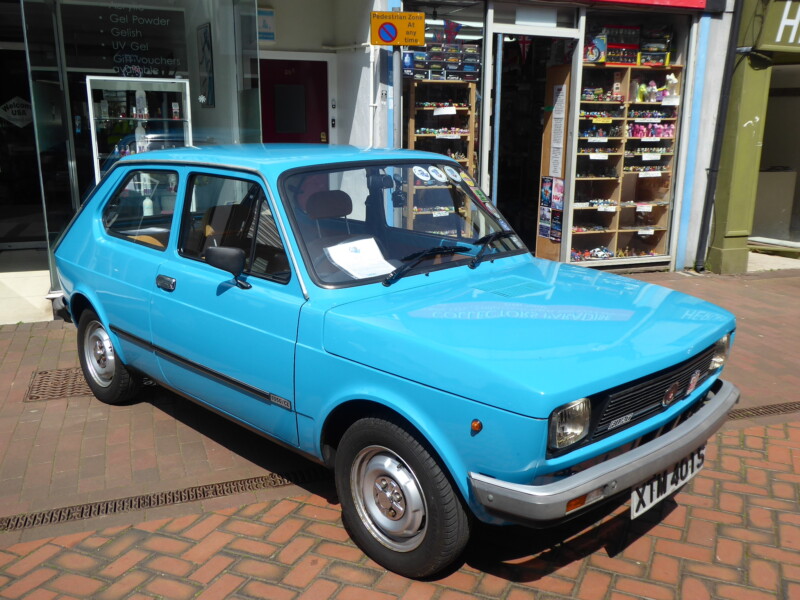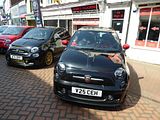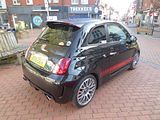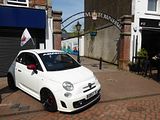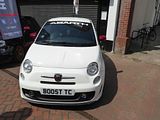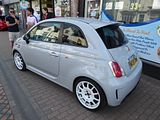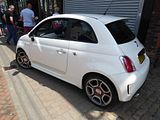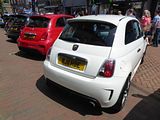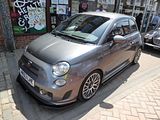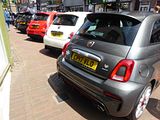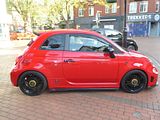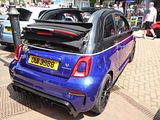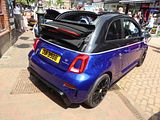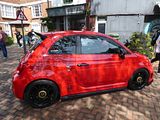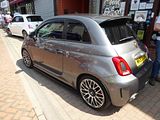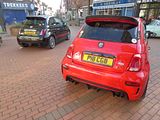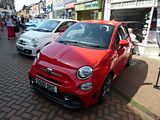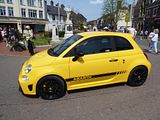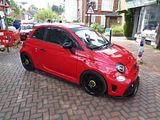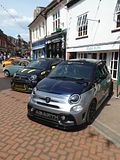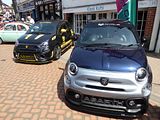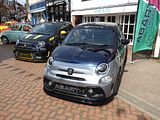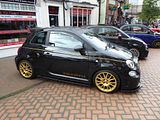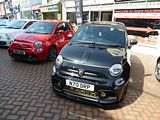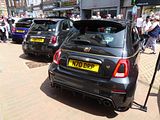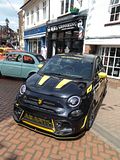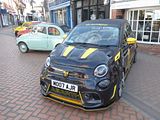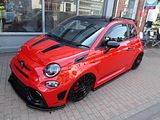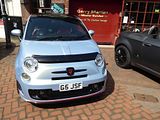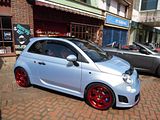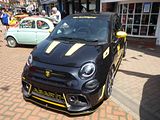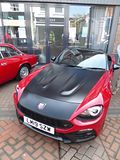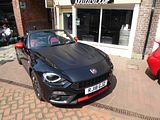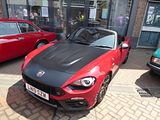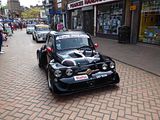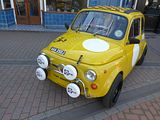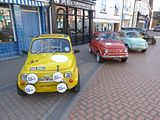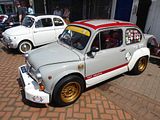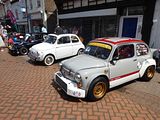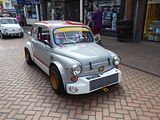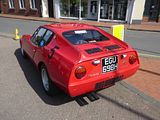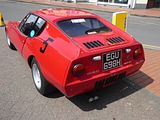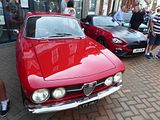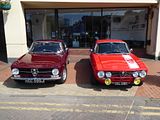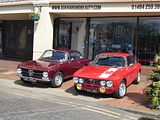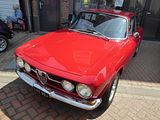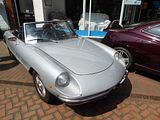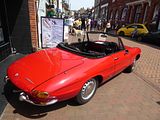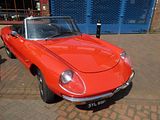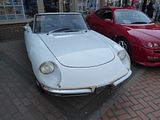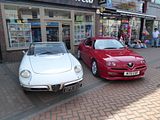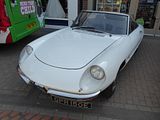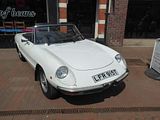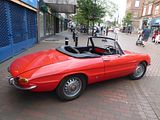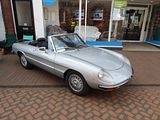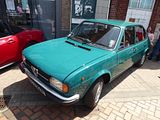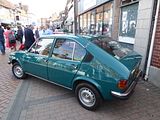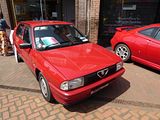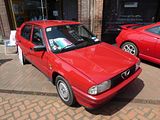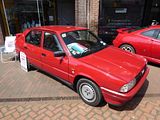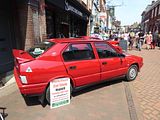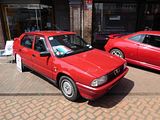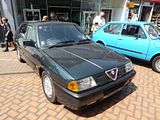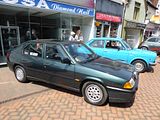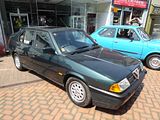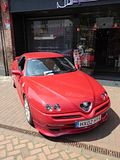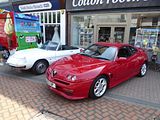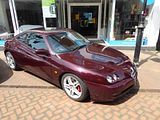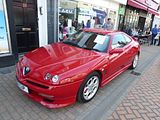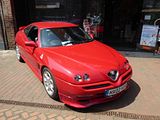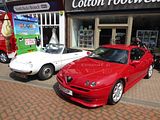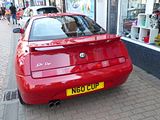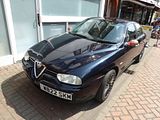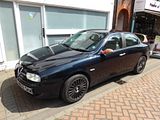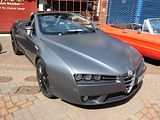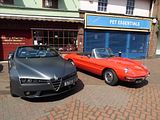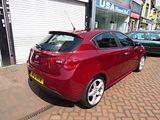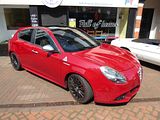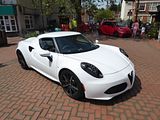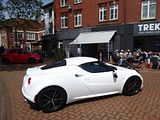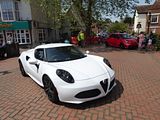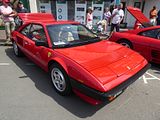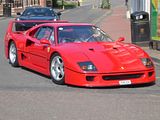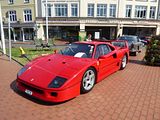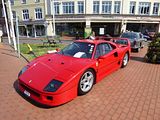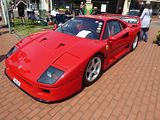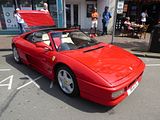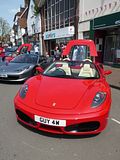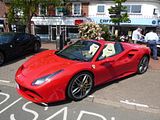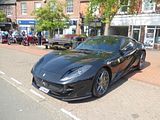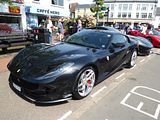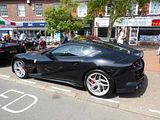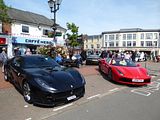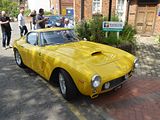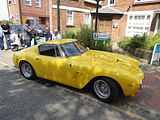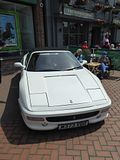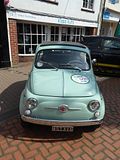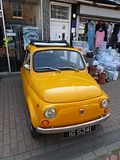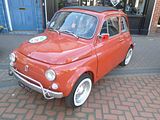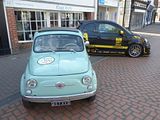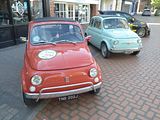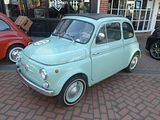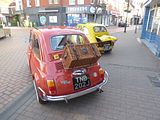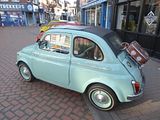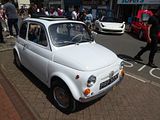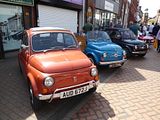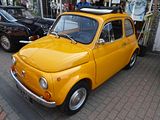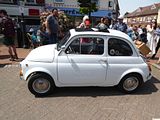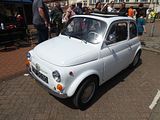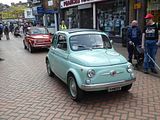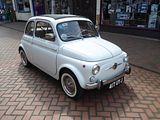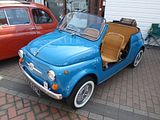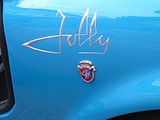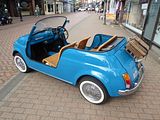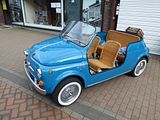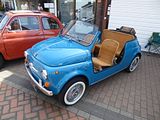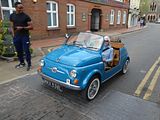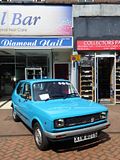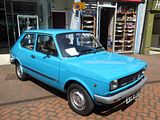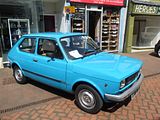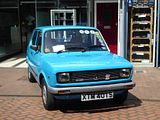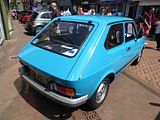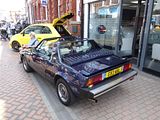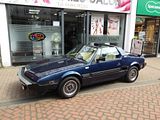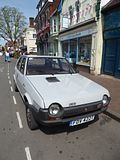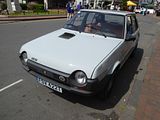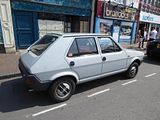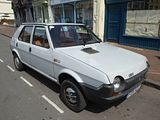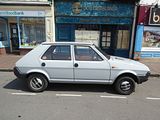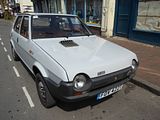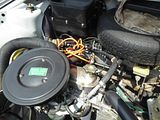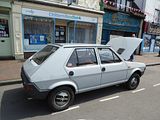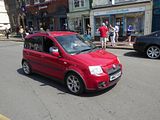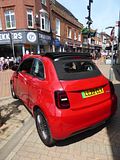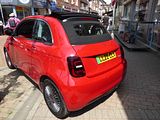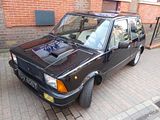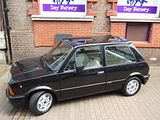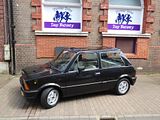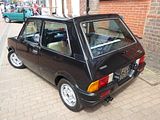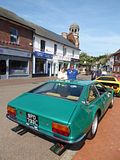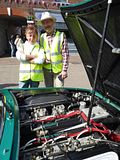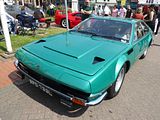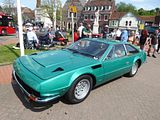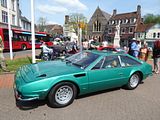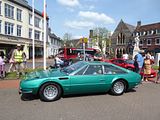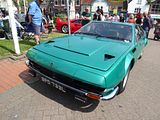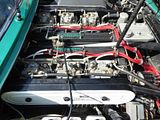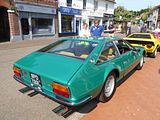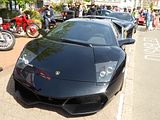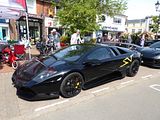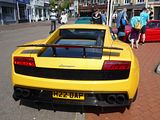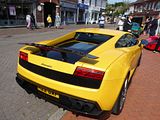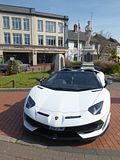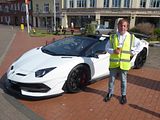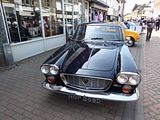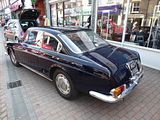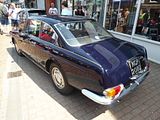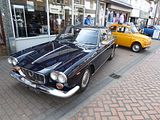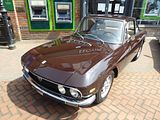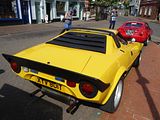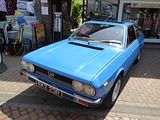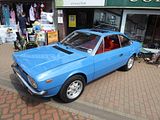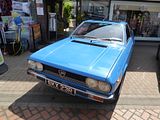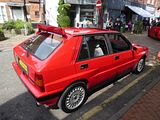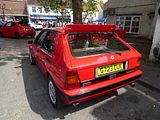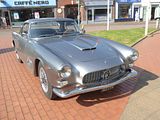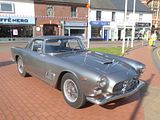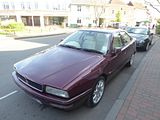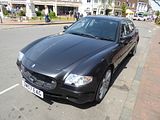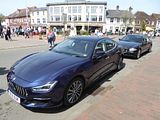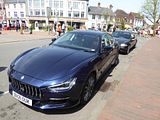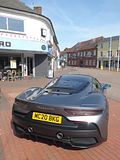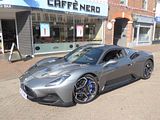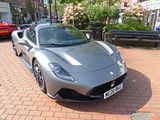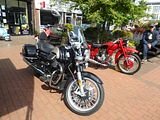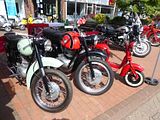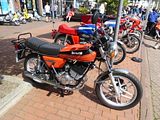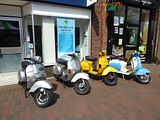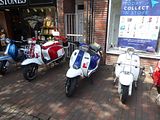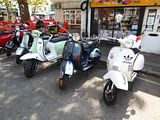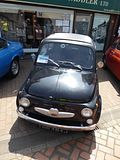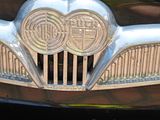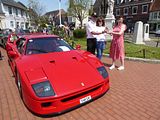Just one week after a great day of Italian Cars and Bikes at the RAF Cosford museum, the Italian Auto Moto Club (IAMC) had another event on the calendar. This one was in Chesham, the furthest east the IAMC has ever ventured. Inspiration for the event came from local resident Mark Rosales, who came to the IAMC event in Devizes last summer and spotted the potential to do something in this Buckinghamshire country town. With the Mayor seeing the potential for raising the profile of the town and support from the Rotary Club, Mark spent many months over the winter patiently gaining all the necessary support from the various Council bodies and getting all the legal and other planning activities worked through, leaving the IAMC free to concentrate on getting cars booked in and running the event on the day. And what a day it was. With the promise of sunny skies and no rain in forecast, the original entry list grew somewhat in the days leading up to the event to the extent that we were a little worried whether we would have space for all the cars and bikes that had entered. Chesham High Street looks quite big on a map or when you walk it when it is empty, but start populating it with Italian cars and soon it looks quite different. The hope was to get representation from all the Italian marques and a really diverse mix of cars from those that you often to see to those you rarely come across and that is exactly what we had on the day.
ABARTH
The vast majority of Abarth cars here were the 500-based models which have been on sale now since the end of 2008, following a launch at the Paris Show that year. Since that time there have been a number of detailed changes to the standard cars and a lot of limited editions. Those who really know the marque can spot most of them, but some are so subtle that unless there is a badge you can see, you will not be quite sure which version you are looking at. It used to be relatively easy, when the model was first launched, as there was only one version as shipped ex works called the 500. It had a 135 bhp 1.4 litre turbo-charged engine coupled to a five speed manual gearbox, with 16″ alloys as standard, and the option of 17″ wheels, and a colour palette comprising of two whites (BossaNova White, the standard colour, or the pearlescent Funk White), Red (Pasadoble), Pale Grey (Campovolo) or Black. If you wanted more power – 160 bhp – then you could order an Esseesse kit, which came in a large wooden crate, containing new wheels, springs, an ECU upgrade, the Monza exhaust system and badging. It was dealer fitted and could be applied at any time within the first 12 months or 10,000 miles from registration. Needless to say, it proved popular. As were many of the optional extras, with stickers for the sides, a large scorpion for the bonnet and even a chequered pattern for the roof among the personalisation options offered.
Having used the legendary 695 badging from the 1960s on the Tributo cars, at the 2012 Geneva Show, Abarth dusted off the 595 name that had been used on the less powerful of the Nuova 500 based cars of the same generation, and created two new versions which we should think of as Series 2 cars, the 595 Turismo and Competizione, both of which could be bought in either closed or open top C guise, with either the 5 speed manual or robotised automated gearshifts. Both models had the 160 bhp engine as standard. Effectively they were a replacement for the Esseesse kit, and it meant that the cars were produced complete at the factory, rather than needing the dealer to undertake the upgrade (and the associated paperwork), though Abarth did not withdraw the Esseesse kits from the market for some while. Turismo, as the name suggests was aimed slightly less extreme in intent, featuring standard leather upholstery, upgraded dampers and climate control, Xenon headlights and Alutex interior details. The sportier Abarth 595 Competizione replaced the leather seats with Sabelt cloth sport seats and Alutex with aluminium, while adding p-cross-drilled brakes and the Record Monza dual-mode exhaust.
What is known as the Series 4 version of the familiar 595 reached the markets in the middle of 2016. After rumours had circulated all winter following the launch of the facelifted Fiat 500 last year, Abarth finally unveiled the Series 4 at the end of May 2016. Initially, we were told that the cars would not be available in the UK until September, but that came forward somewhat, with dealers all receiving demo cars in June, and the first customers taking delivery in July. Three regular production versions of both the closed car and the open-topped C were initially available, all badged 595, and called Custom, Turismo and Competizione, as before, though numerous limited edition models have since appeared and in most case disappeared. The most significant changes with the Series 4 are visual, with a couple of new colours, including the much asked for Modena Yellow and a different red, called Abarth Red, which replaces both the non-metallic Officina and – slightly surprisingly – the tri-coat pearlescent Cordolo Red. as well as styling changes front and rear. The jury is still out on these, with many, me included, remaining to be convinced. At the front, the new air intake does apparently allow around 15 – 20 % more air in and out, which will be welcome, as these cars do generate quite a lot of heat under the bonnet. Competizione models for the UK retain the old style headlights, as they have Xenon lights as standard, whereas the Custom and Turismo cars have reshaped units. At the back, there are new light clusters and a new rear bumper and diffuser. Inside, the most notable change is the replacement of the Blue & Me system with a more modern uConnect Audio set up, which brings a new colour screen to the dash. Mechanically, there is an additional 5 bhp on the Custom (now 145) and Turismo (now 165 bhp) and the option of a Limited Slip Diff for the Competizione, which is likely to prove a popular option. Details of the interior trim have changed, with a filled-in glovebox like the US market cars have always had, and electric windows switches that are like the US ones, as well as a part Alcantara trim to the steering wheel in Competizione cars. These cars have now been on offer for seven years and with Abarth sales on the rise, it was no surprise that they were particularly well represented here.
More recently, Abarth have produced the 695 Rivale, a celebration of Fiat’s partnership with Riva, which has already seen a special Riva version of the 500,. Described as being “the most sophisticated Abarth ever”, it is available either as a hatch or a cabriolet, with both of them featuring a two-tone Riva Sera Blue and Shark Grey paintwork. The Rivale is adorned with an aquamarine double stripe, satin chrome finish on the door handles and satin chrome moulding on the tailgate, various aesthetic elements inspired by the Riva 56 Rivale yachts and ‘695 Rivale’ logos, joined by Brembo Brakes, Koni suspension, and 17-inch Supersport alloy wheels. Enhancing the nautical theme the new 695 Rivale features either a carbon fibre or mahogany dashboard, black mats with blue inserts, blue leather seats and door panels, carbon fibre kick plates, special steering wheel wrapped in blue and black leather and with a mahogany badge, blue leather instrument panel cover, and mahogany gear lever knob and kick plate. These are joined by the standard Uconnect infotainment with a 7-inch display, which is compatible with Android Auto and Apple CarPlay, and there is also a hand-written numbered plate that can be customised with the mane of the customer’s yacht on request. Powering the 695 Rivale is the same 1.4-litre turbocharged engine that makes 180PS (177hp) and 184lb/ft of torque, that features in the 595 Competizione, allowing it to go from rest to 100km/h (62mph) in 6.7 seconds and up to a top speed of 225km/h (140mph). This is a regular model in the range, but confusingly, there is also the Abarth 695 Rivale 175 Anniversary, created to celebrate 175 years of the Riva brand. Just 350 of these were produced, half of them the hatch and the other half cabriolets. These featured 17-inch alloy wheels with a special pattern, celebratory badge on the outside, hand-crafted details such as the two-tone colour – blue and black hand-stitched leather seats with a celebratory logo stitched onto the headrest, carbon dashboard silk screen printed with special logo, numbered plate. Standard Rivale cars arrived in the UK in April 2018, and quite a few have been sold. They always attract lots of interest when they do appear.
Abarth announced two limited edition models in the autumn of 2020 and one of these was here, the 595 Scorpioneoro. Another model which takes its inspiration from a history which few in the Uk will be familiar with, there will be just 2000 units of this distinctive model available globally. The 595 Scorpioneoro was born to continue the legacy of the famous A112 Abarth “Gold Ring” of 1979, better known as the A112 Abarth “Targa Oro”, of which only 150 models produced and, as with the new Abarth 595 Scorpioneoro, what made it so special were its stylistic details. These details included black livery, gold-coloured decorative line contouring the bodywork and the alloy wheels, also painted in the distinctive gold colour. This car is liveried in the same way, marked out by its black livery, decorative gold bodywork lining and gold-painted alloy wheels. It also boasts a matt black chessboard roof and grey finish on the door handles and mirror caps. And to mirror the ‘Gold Scorpion’ name, the car is adorned with gold scorpions on the bonnet and the wheel centres. Inside the cabin of this new exciting new model, you’ll be greeted with a black dashboard which is home to the new gold finished 500 logo. Leather detailing on the seats introduces the original “scorpionflage”. The seats are further embellished with dedicated stitching and personalised headrests with the word “Scorpioneoro”, the Italian flag and Abarth embroidered on them. An additional touch of exclusivity comes from the numbered, gold coloured plaque, available solely on this model. The Scorpioneoro also comes with Abarth’s top-of-the-range seven-inch touchscreen infotainment system, complete with Apple CarPlay and Android Auto, as well as a Beats Audio sound system. Mechanically, there is nothing new, as the car has the 165 bhp version of the familiar T-Jet engine and the other features you get in the regular production Trofeo cars.
Many owners modify their cars. Some of the changes are concentrated on mechanical things with the appearance remaining standard whereas others change the look of the car, with everything from additional spoilers and splitters to a full body wrap, resulting in some distinctive looking and unique cars. There were a number of examples of this here, including Mark Rosales’ black car with lots of yellow and carbon fibre additions.
The Abarth 124 Spider was developed in parallel with the Fiat model. It does cost a lot more, and there are those who think you don’t get enough extra for your money, but those who have driven it will tell you otherwise. You certainly get more power. The 1.4 MultiAir turbo unit jumps up from 138bhp to 168bhp, while torque also increases by a modest 10Nm to 250Nm, which gives it a 0-62mph time of 6.8 seconds, which is half a second quicker than the 2.0-litre Mazda MX-5. The top speed is 143mph. It weighs just 1060kg meaning a power-to-weight ratio of 158bhp-per-tonne, and with the new Record Monza exhaust system it sounds great even at idle. The Abarth version gets a stiffer suspension setup than the regular Fiat 124 Spider, with Bilstein dampers and beefed-up anti-roll bars. Bigger Brembo brakes also feature, with aluminium calipers. It can be had with a six-speed manual or six-speed automatic transmission with paddles, and the latter gets a Sport mode for quicker shifts. Many of the UK cars sport the ‘Heritage Look’ pack, which is a no-cost option. It brings a matt black bonnet and bootlid, plus red exterior trim detailing and has proved popular. The £29,565 starting price gets you standard equipment such as cruise control, climate control, Bluetooth, a DAB radio and satnav, plus Alcantara black and red (or pure black) seat trim. The automatic gearbox is a £2,035 extra, while an optional visibility pack brings LED DRLs, auto lights and wipers and rear parking sensors. Sales ceased during 2019, with around 1800 cars having been brought into the UK, so this is always going to be a rare car, and values are already increasing at a rate reflecting its desirability and the difficulty in finding one.
Seen often at Italian car gatherings, especially in the South East is Carlo Cacciavelli’s car. Although this amazing machine has the form of a classic Nuova 500, don’t be too taken in by that. The car is actually built on a chassis that has its origins in the Abarth Osella 2000SP sports racing car, with double wishbone suspension and disc brakes front and rear. Sitting in the back is a fuel injected 1.5 litre Alfa Romeo “boxer” engine of the type originally found in the front of the Alfa Romeo ‘Sud, Sprint 33 and even the Nissan Arna GTi. It is coupled to an Alfa 5-speed gearbox. Carlo’s coachwork company built the special extra wide body, which is all steel. The car was first registered in the UK on the 28th July 2000 and it has been seen at a great variety of events ever since. It never fails to pull the crowds wherever it its taken.
For the 595 SS, Abarth increased the engine capacity to 594 cc, just under the limit for the European 600cc racing sedan class. High compression 10:1 pistons were used together with a special camshaft, a specific alloy sump, Abarth valve covers and air filter, propped up engine lid and wheels were fitted and of course the exhaust system was a special in house model. This package together with lowered suspension, flared arches and 10 inch rims amounted to what was known as the Assetto Corsa SS model. These cars have become very rare as many were crashed in competition or simply rotted away due to bad rust protection in the 70s. A number of recreations have been built, such as this one created for Victor Mayer by Tristan Brunt.
There is a complex history to the rest of the 600-based Abarths, starting with the 850TC, which actually predates the better known 595/695 cars. Officially known as the Fiat-Abarth 850TC Berlina (Turismo Competizione, or “touring competition”), it was introduced towards the end of 1960, using Fiat 600 bodywork with some modifications, most notably a boxlike structure ahead of the front bumper which held the engine’s oil cooler. The rear wings were usually blistered, to accommodate larger wheels. The engine is a four-cylinder model based on a Fiat unit, with 847 cc capacity and 51 hp. Overall length is 3,090 mm (122 in), overall width is 1,400 mm (55 in), height is 1,380 mm (54 in), wheelbase is 2,000 mm (80 in), and its front and rear track are 1,160 mm (46 in). The fuel tank holds 5.9 imperial gallons, and its empty weight was 793 kg (1,748 lb). The 850TC remained in the price lists until 1966. In 1962 the 850TC Nürburgring was introduced, with 55 PS at 6500 rpm. The name was intended to celebrate the class victory of an Abarth 850TC at the 1961 Nürburgring 500 km race. There followed the 850TC/SS with two more horsepower; this was renamed the 850TC Nürburgring Corsa towards the end of the year. Between 1962 and 1971 the 850cc and 1000cc class cars won hundreds of races all over the World and were commonly called “Giant Killers” due to their superior performance over much larger cars, culminating in a famous dispute with SCCA authorities in the USA when Alfred Cosentino (FAZA) was banned from running his 1970 Fiat Abarth Berlina Corsa 1000 TCR “Radiale” engine because his car was faster (mainly in wet conditions) to many V8 Mustangs, AMC AMX’s and Chev Camaro’s etc. The SCCA authorities dictated FAZA and Cosentino be forced to use an early design engine a non “Radiale” engine from 1962 model in his cars but still achieved 51 Victories from 53 races. The most victories in SCCA racing history, thereby cementing the superiority of the Fiat Abarth Berlina Corsa over larger and more powerful cars.
There was one of the Lombardi Grand Prix-based Abarth models here. Although many have now seen them a number of times in the past couple of years, they remain a car that few can identify with any confidence. It was based on the Lombardi Grand Prix, you most have probably never heard of that, either! The Lombardi Grand Prix was a small, rear-engined sports car, based on Fiat 850 underpinnings, developed by the Carrozzeria Francis Lombardi with an in-house design by Giuseppe Rinaldi. It was first shown in March 1968, at the Geneva Motor Show. The design had a Kammback rear and a very low nose with flip-up headlights, and a large single windshield wiper. The headlights were electrically powered. The bodywork was all steel, except the rear panel. The design was originally shown as a prototype based on the front-wheel drive Autobianchi A112, and was adapted by Lombardi for the 850 sedan’s floorpan. At the 1969 Turin Show, a targa version was also shown; called the “Monza”, this open model has a rollover bar. At least two were built but it is unknown whether any were sold. The original Lombardi Grand Prix had the regular 843 cc Fiat 850 engine with 37 PS at 5000 rpm, coupled to a four-speed gearbox. Low drag resistance and weight (630 kg or 1,390 lb) meant that this was supposedly enough for a top speed of 99 mph. Later production models had the 850 Special engine, with 47 PS at 6400 rpm – in a period German test the maximum speed of the more powerful variant was 95.6 mph. Luggage space is limited, with very little space next to the spare wheel up front and with a tiny area behind the seats. In case the electric wind-up mechanism for the headlights should fail, there is also a mechanical lever underneath the bonnet. The single round tail lights are Fiat 850 Coupé units. The front suspension consists of a transverse leaf spring on the bottom and A-arms on top, while the rear received coil sprung semi-trailing arms. The Lombardi Grand Prix was built in two series: early models used the regular, metal engine cover from the Fiat 850 while the Series II has a louvred unit in black metal. The door windows are also different, being of a three-piece design (one on top, two lower pieces of which one could be slid open) while later cars have a more conventional layout with a vent window up front and a single piece which, however, could only be rolled halfway down. A Cypriot casino owner and millionaire had also shown interest in the Lombardi Grand Prix around the time of its introduction. Frixos Demetriou intended to market the car in the United Kingdom and began planning for an order of 1000 cars. After his death in a British Army tank accident in Cyprus, this project came to a sudden halt. Only ten cars were imported into the UK, with the remaining parts languishing in storage in Turin. A few unsold cars were re-exported to Cyprus in 1969 to avoid pending customs bills. The story gets more complex than that. The tiny OTAS company (Officina Trasformazioni Automobili Sportive, or “Sports car conversion shop”) was founded in 1969 and was a collaboration between Francis Lombardi and Franco Giannini – the son of Domenico Giannini of Giannini Automobili – allowing for a more powerful, Giannini-engined Grand Prix model to be marketed abroad. The resulting OTAS Grand Prix has a tuned, 982 cc twin-cam “Tigre” engine. In Italy, this model was sold as the “Giannini 1000 Grand Prix” (beginning in 1969). In a very convoluted operation, Francis Lombardi sold engineless cars to Giannini, while Giannini sold their engines to OTAS for sale outside of Italy. Responding to interest in the important North American market, OTAS also sold the Grand Prix in the United States and in Canada as the “OTAS Grand Prix 820cc”, to give the tiny car its full name. Going on sale in 1970 it was fitted with the same down-sleeved 817 cc version of the inline-four engine as used in federalised Fiat 850s – all to sneak under 50 cubic inches, thereby avoiding the need to carry emissions controls equipment. Sixty-five of these cars were brought to North America, or perhaps as many as a hundred. Fiat 850 chassis numbers were retained for the OTAS 820. Importer John Rich of Glendale, California, also offered tune-up kits directly and Siata International in New Jersey imported nine of the bigger Tigre-engined cars before the strictures of the EPA put a halt to such activities. This was the first car to have US sales curtailed by the EPA. The OTAS was sold until 1971, when the company shut its doors following homologation troubles. The car never sold particularly well, being expensive considering its performance and with a tendency to overheat. Along with other tuners (such as Giannini), Carlo Abarth also had a look at the Grand Prix. Abarth’s version, first seen at the 1968 Paris Motor Show, received a tuned version of the larger 903 cc engine from the recently introduced Fiat 850 Sport Coupé/Sport Spider. The resulting variant has a claimed 52 PS, providing performance more suitable to the sporting bodystyle and name. For better cooling than the original Lombardi and OTAS, Abarth mounted the cooler up front, in the air stream. In 1970 Abarth showed the considerably more powerful “Abarth 1300 Scorpione”, which was to be Abarth’s last independently developed car. Equipped with a version of the Fiat 124s 1.2 litre engine, bored out by 2.5 mm for a total of 1280 cc, this model has 75 PS and only moderately more weight, ranging from 680 to 750 kg (1,500 to 1,650 lb) depending on the source. In a 1970 road test by Auto, Motor und Sport, the Scorpione reached 109.1 mph, close to the claimed 112 mph. There is also mention of a 982 cc Abarth 1000 OT-engined version of the Scorpione. The Scorpione had a special Abarth-made bell housing, to allow matching the 124 engine to the four-speed 850 gearbox. After Abarth was taken over by Fiat in 1971, the Scorpione was quickly cancelled.
ALFA ROMEO
The first car was called the Alfa Romeo Giulia Sprint GT, and was revealed at a press event held at the then newly opened Arese plant on 9 September 1963, and displayed later the same month at the Frankfurt Motor Show. In its original form the Bertone body is known as scalino (step) or “step front”, because of the leading edge of the engine compartment lid which sat 1/4 an inch above the nose of the car. The Giulia Sprint GT can be distinguished from the later models by a number of features including: Exterior badging: Alfa Romeo logo on the front grille, a chrome script reading “Giulia Sprint GT” on the boot lid, and rectangular “Disegno di Bertone” badges aft of the front wheel arches; flat, chrome grille in plain, wide rectangular mesh without additional chrome bars; single-piece chrome bumpers; no overriders. Inside the cabin the padded vinyl dashboard was characterised by a concave horizontal fascia, finished in grey anti-glare crackle-effect paint. Four round instruments were inset in the fascia in front of the driver. The steering wheel was non-dished, with three aluminium spokes, a thin bakelite rim and a centre horn button. Vinyl-covered seats with cloth centres and a fully carpeted floor were standard, while leather upholstery was an extra-cost option. After initially marketing it as a four-seater, Alfa Romeo soon changed its definition of the car to a more realistic 2+2. The Giulia Sprint GT was fitted with the 1,570 cc version of Alfa Romeo’s all-aluminium twin cam inline four (78 mm bore × 82 mm stroke), which had first debuted on the 1962 Giulia Berlina. Breathing through two twin-choke Weber 40 DCOE 4 carburettors, on the Sprint GT this engine produced 105 hp at 6,000 rpm. Like all subsequent models, the Sprint GT was equipped with an all-synchromesh 5-speed manual transmission. The braking system comprised four Dunlop disc brakes and a vacuum servo. The rear brakes featured an unusual arrangement with the slave cylinders mounted on the axle tubes, operating the calipers by a system of levers and cranks. According to Alfa Romeo the car could reach a top speed of “over 180 km/h (112 mph)”. In total 21,902 Giulia Sprint GT were produced from 1963 to 1965, when the model was superseded by the Giulia Sprint GT Veloce. Of these 2,274 were right hand drive: 1,354 cars fully finished in Arese, and 920 shipped in complete knock-down kit form for foreign assembly. For 1966, the Giulia Sprint GT was replaced by the Alfa Romeo Giulia Sprint GT Veloce, which was very similar but featuring a number of improvements: a revised engine—slightly more powerful and with more torque—better interior fittings and changes to the exterior trim. Alongside the brand new 1750 Spider Veloce which shared its updated engine the Sprint GT Veloce was introduced at the 36th Geneva Motor Show in March 1966, and then tested by the international specialist press in Gardone on the Garda Lake. Production had began in 1965 and ended in 1968. The Giulia Sprint GT Veloce can be most easily distinguished from other models by the following features: badging as per Giulia Sprint GT, with the addition of round enamel badges on the C-pillar—a green Quadrifoglio (four-leaf clover) on an ivory background—and a chrome “Veloce” script on the tail panel; black mesh grille with three horizontal chrome bars; the grille heart has 7 bars instead of 6; stainless steel bumpers, as opposed to the chromed mild steel bumpers on the Giulia Sprint GT. The bumpers are the same shape, but are made in two pieces (front) and three pieces (rear) with small covers hiding the joining rivets. Inside the main changes from the Giulia Sprint GT were imitation wood dashboard fascia instead of the previous anti-glare grey finish, front seats revised to a mild “bucket” design, and a dished three aluminium spoke steering wheel, with a black rim and horn buttons through the spokes. The Veloce’s type 00536 engine, identical to the Spider 1600 Duetto’s, featured modifications compared to the Giulia Sprint GT’s type 00502—such as larger diameter exhaust valves. As a result it produced 108 hp at 6,000 rpm, an increase of 3 hp over the previous model, and significantly more torque. The top speed now exceeded 185 km/h (115 mph). Early Giulia Sprint GT Veloces featured the same Dunlop disc brake system as the Giulia Sprint GT, while later cars substituted ATE disc brakes as pioneered on the GT 1300 Junior in 1966. The ATE brakes featured an handbrake system entirely separate from the pedal brakes, using drum brakes incorporated in the rear disc castings. Though the Sprint GT Veloce’s replacement—the 1750 GT Veloce—was introduced in 1967, production continued throughout the year and thirty final cars were completed in 1968. By then total Giulia Sprint GT Veloce production amounted to 14,240 examples. 1,407 of these were right hand drive cars, and 332 right hand drive complete knock-down kits. The Alfa Romeo 1750 GT Veloce (also known as 1750 GTV) appeared in 1967 along with the 1750 Berlina sedan and 1750 Spider. The same type of engine was used to power all three versions; this rationalisation was a first for Alfa Romeo. The 1750 GTV replaced the Giulia Sprint GT Veloce and introduced many updates and modifications. Most significantly, the engine capacity was increased to 1779 cc displacement. Peak power from the engine was increased to 120 hp at 5500 rpm. The stroke was lengthened from 82 to 88.5 mm over the 1600 engine, and a reduced rev limit from 7000 rpm to 6000 rpm. Maximum torque was increased to 137 lb·ft at 3000 rpm. A higher ratio final drive was fitted (10/41 instead of 9/41) but the same gearbox ratios were retained. The result was that, on paper, the car had only slightly improved performance compared to the Giulia Sprint GT Veloce, but on the road it was much more flexible to drive and it was easier to maintain higher average speeds for fast touring. For the United States market, the 1779 cc engine was fitted with a fuel injection system made by Alfa Romeo subsidiary SPICA, to meet emission control laws that were coming into effect at the time. Fuel injection was also featured on Canadian market cars after 1971. Carburettors were retained for other markets. The chassis was also significantly modified. Tyre size went to 165/14 from 155/15 and wheel size to 5 1/2J x 14 instead of 5J x 15, giving a wider section and slightly smaller rolling diameter. The suspension geometry was also revised, and an anti-roll bar was fitted to the rear suspension. ATE disc brakes were fitted from the outset, but with bigger front discs and calipers than the ones fitted to GT 1300 Juniors and late Giulia Sprint GT Veloces. The changes resulted in significant improvements to the handling and braking, which once again made it easier for the driver to maintain high average speeds for fast touring. The 1750 GTV also departed significantly from the earlier cars externally. New nose styling eliminated the “stepped” bonnet of the Giulia Sprint GT, GTC, GTA and early GT 1300 Juniors and incorporated four headlamps. For the 1971 model year, United States market 1750 GTV’s also featured larger rear light clusters (there were no 1970 model year Alfas on the US market). Besides the chrome “1750” badge on the bootlid, there was also a round Alfa Romeo badge. Similar Quadrofoglio badges to those on the Giulia Sprint GT Veloce were fitted on C pillars, but the Quadrofoglio was coloured gold instead of green. The car also adopted the higher rear wheelarches first seen on the GT 1300 Junior. The interior was also much modified over that of earlier cars. There was a new dashboard with large speedometer and tachometer instruments in twin binnacles closer to the driver’s line of sight. The instruments were mounted at a more conventional angle, avoiding the reflections caused by the upward angled flat dash of earlier cars. Conversely, auxiliary instruments were moved to angled bezels in the centre console, further from the driver’s line of sight than before. The new seats introduced adjustable headrests which merged with the top of the seat when fully down. The window winder levers, the door release levers and the quarterlight vent knobs were also restyled. The remote release for the boot lid, located on the inside of the door opening on the B-post just under the door lock striker, was moved from the right hand side of the car to the left hand side. The location of this item was always independent of whether the car was left hand drive or right hand drive. Early (Series 1) 1750 GTV’s featured the same bumpers as the Giulia Sprint GT Veloce, with the front bumper modified to mount the indicator / sidelight units on the top of its corners, or under the bumper on US market cars. The Series 2 1750 GTV of 1970 introduced other mechanical changes, including a dual circuit braking system (split front and rear, with separate servos). The brake and clutch pedals on left hand drive cars were also of an improved pendant design, instead of the earlier floor-hinged type. On right hand drive cars the floor-hinged pedals were retained, as there was no space for the pedal box behind the carburettors. Externally, the series 2 1750 GTV is identified by new, slimmer bumpers with front and rear overriders. The combined front indicator and sidelight units were now mounted to the front panel instead of the front bumper, except again on the 1971-72 US/Canadian market cars. The interior was slightly modified, with the seats retaining the same basic outline but following a simpler design. 44,269 1750 GTVs were made before their replacement came along. That car was the 2000GTV. Introduced in 1971, together with the 2000 Berlina sedan and 2000 Spider, the 2 litre cars were replacements for the 1750 range. The engine displacement was increased to 1962 cc. Oil and radiator capacities remained unchanged. The North American market cars had fuel injection, but everyone else retained carburettors. Officially, both versions generated the same power, 130 hp at 5500 rpm. The interior trim was changed, with the most notable differences being the introduction of a separate instrument cluster, instead of the gauges installed in the dash panel in earlier cars. Externally the 2000 GTV is most easily distinguished by its grille with horizontal chrome bars, featuring protruding blocks forming the familiar Alfa heart in outline, smaller hubcaps with exposed wheel nuts, optional aluminium alloy wheels of the same size as the standard 5. 1/2J × 14 steel items, styled to the “turbina” design first seen on the alloy wheels of the Alfa Romeo Montreal, and the larger rear light clusters first fitted to United States market 1750 GTV’s were standard for all markets. From 1974 on, the 105 Series coupé models were rationalised and these external features became common to post-1974 GT 1300 Junior and GT 1600 Junior models, with only few distinguishing features marking the difference between models. 37,459 2000 GTVs were made before production ended and these days they are very sought after with prices having sky-rocketed in recent years.
Alfa replaced the Giulia-based Spider model with an all-new design which finally made its debut in 1966 together with the Giulia Sprint GT Veloce at an event organised in Gardone Riviera. With its boat tailed styling, it quickly found favour, even before taking a starring role in the film “The Graduate”. The original 1600cc engine was replaced by a more powerful 1750cc unit at the same time as the change was made to the rest of the range, and the car continued like this until 1970, when the first significant change to the exterior styling was introduced on the 1750 Spider Veloce, with the original’s distinctive elongated round tail changed to a more conventional cut-off tail, called the “Kamm tail”, as well as improving the luggage space. Numerous other small changes took place both inside and out, such as a slightly different grille, new doorhandles, a more raked windscreen, top-hinged pedals and improved interior trim. 1971 saw the Spider Veloce get a new, larger powerplant—a 1962 cc, 132 hp unit—and consequently the name was changed from 1750 Spider Veloce to 2000 Spider Veloce. The 1600 Spider restarted production a year later as the Spider 1600 Junior, and was visually identical to the 1300. 1974 saw the introduction of the rare, factory request, Spider-Targa. Based upon the Spider, it featured a Porsche style solid rear window and lift out roof panels, all made out of black GRP type material. Less than 2,000 models of such type were ever made and was the only part solid roof Spider until the introduction of the factory crafted hard top. The 1300 and 2000 cars were modified in 1974 and 1975 respectively to include two small seats behind the front seats, becoming a “two plus two” four seater. The 1300 model was discontinued in 1977. Also, between 1974 and 1976, the early-style stainless-steel bumpers were discontinued and replaced with black, rubber-clad units to meet increasingly stringent North American crash requirements. 4,557 examples of the 1300 Junior were made and 4,848 of the 1600 Junior as well as 16,320 2000 Spider Veloces and 22,059 of 2000 Spider Veloce US version. There were also 4,027 1750 Spider Veloces produced.
The S4, the final major change to the long running Spider came in 1990, and mechanically, the biggest different was the use of Bosch Motronic electronic fuel injection with an electric fan. Externally, the Spider lost its front under-bumper spoiler and the rather ungainly rear boot spoiler of the S3, and picked up 164-style rear lights stretching across the width of the car as well as plastic bumpers the same colour as the car. This also marked the first generation of the car with automatic transmission, as well as on-board diagnostics capabilities. The car had remained in production largely thanks to continued demand in North America, though this market had to wait until 1991 for the changes to appear on their cars. European markets were offered a car with a 1600cc engine and carburettors as well as the 2 litre injected unit. Production finally ended in 1993, with an all new model, the 916 Series Spider appearing a year later. The S4 car was not officially sold in the UK, but plenty have found their way to our shores since then.
There was just one AlfaSud here, Glen Moffatt’s Series 2. These characterful small cars evoke a very positive reaction, with many people wistfully recollecting one that they, or their parents, owned back in the 1970s, but observing that the car, whilst divine to drive, simply rusted away almost before your very eyes. There are a lot more of these cars left in the UK than you might imagine, but most of them are on SORN, needing massive restorations that may or may not ever happen. That should not detract from the splendour of the models on show at this event. Alfa Romeo had explored building a smaller front wheel drive car in the 1950s but it was not until 1967 that firm plans were laid down for an all-new model to fit in below the existing Alfa Romeo range. It was developed by Austrian Rudolf Hruska, who created a unique engineering package, clothed in a body styled by Giorgetto Giugiaro of ItalDesign. The car was built at a new factory at Pomigliano d’Arco in southern Italy, hence the car’s name, Alfa Sud (Alfa South). January 18, 1968, saw the registration at Naples of a new company named “Industria Napoletana Costruzioni Autoveicoli Alfa Romeo-Alfasud S.p.A.”. 90% of the share capital was subscribed by Alfa Romeo and 10% by Finmeccanica, at that time the financial arm of the government controlled IRI. Construction work on the company’s new state sponsored plant at nearby Pomigliano d’Arco began in April 1968, on the site of an aircraft engine factory used by Alfa Romeo during the war. The Alfasud was shown at the Turin Motor Show three years later in 1971 and was immediately praised by journalists for its styling. The four-door saloon featured an 1,186 cc Boxer water-cooled engine with a belt-driven overhead camshaft on each cylinder head. It also featured an elaborate suspension setup for a car in its class (MacPherson struts at the front and a beam axle with Watt’s linkage at the rear). Other unusual features for this size of car were four-wheel disc brakes (with the front ones being inboard) and rack and pinion steering. The engine design allowed the Alfasud a low bonnet line, making it very aerodynamic (for its day), and in addition gave it a low centre of gravity. As a result of these design features, the car had excellent performance for its engine size, and levels of roadholding and handling that would not be equaled in its class for another ten years. Despite its two-box shape, the Alfasud did not initially have a hatchback. Some of the controls were unorthodox, the lights, turn indicators, horn, wipers and heater fan all being operated by pulling, turning or pushing the two column stalks. In November 1973 the first sport model joined the range, the two-door Alfasud ti—(Turismo Internazionale, or Touring International).Along with a 5-speed gearbox, it featured a more powerful version of the 1.2 engine, brought to 67 hp by adopting a Weber twin-choke carburettor; the small saloon could reach 160 km/h. Quad round halogen headlamps, special wheels, a front body-colour spoiler beneath the bumper and rear black one around the tail distinguished the “ti”, while inside there were a three-spoke steering wheel, auxiliary gauges, leatherette/cloth seats, and carpets in place of rubber mats. In 1974, Alfa Romeo launched a more upscale model, the Alfasud SE. The SE was replaced by the Alfasud L (Lusso) model introduced at the Bruxelles Motor Show in January 1975. Recognisable by its bumper overriders and chrome strips on the door sills and on the tail, the Lusso was better appointed than the standard Alfasud (now known as “normale”), with such features as cloth upholstery, headrests, padded dashboard with glove compartment and optional tachometer. A three-door estate model called the Alfasud Giardinetta was introduced in May 1975. It had the same equipment of the Alfasud “L”. It was never sold in the UK and these models are particularly rare now. The Lusso model was produced until 1976, by then it was replaced with the new Alfasud 5m (5 marce, five speed) model, the first four-door Alfasud with a five-speed gearbox. Presented at the March 1976 Geneva Motor Show, it was equipped like the Lusso it replaced. In late 1977 the Alfasud Super replaced the range topping four-door “5m”; it was available with both the 1.2- and 1.3-litre engines from the “ti”, though both equipped with a single-choke carburettor. The Super introduced improvements both outside, with new bumpers including large plastic strips, and inside, with a revised dashboard, new door cards and two-tone cloth seats. Similar upgrades were applied to the Giardinetta. In May 1978 the Sprint and “ti” got new engines, a 78 hp 1.3 (1,350 cc) and a 84 hp 1.5 (1,490 cc), both with a twin-choke carburettor. At the same time the Alfasud ti received cosmetic updates (bumpers from the Super, new rear spoiler on the boot lid, black wheel arch extensions and black front spoiler) and was upgraded to the revised interior of the Super. The 1.3 and 1.5 engines were soon made available alongside the 1.2 on the Giardinetta and Super, with a slightly lower output compared to the sport models due to a single-choke carburettor. All Alfasuds were upgraded in 1980 with plastic bumpers, new instrument panel, headlamps and rear lights as well as other revisions. The Ti version was now fitted with a twin-carburettor version of the 1490 cc engine that had been fitted to the Sprint the previous year, developing 95 bhp A three-door hatchback was added to the range in 1981 in either SC or Ti trim and the two-door Ti and Giardinetta were deleted from most markets around this time. Belatedly in 1982 the four-door cars were replaced by five-door versions as by now, most of its competitors were producing a hatchback of this size, although some also produced a saloon alternative. The range was topped by the five-door Gold Cloverleaf, featuring the 94 hp engine from the Ti and enhanced interior trim. In 1983 an attempt to keep pace with the hot hatchback market, the final version of the Alfasud Ti received a tuned 1490 cc engine developing 105 PS Now named Quadrifoglio Verde (Green Cloverleaf) this model was also fitted with Michelin low profile TRX tyres on metric rims as well as an enhanced level of equipment. The five-door Alfasud saloons were replaced by the 33 models in 1983. The 33 was an evolution of the AlfaSud’s floorpan and running gear, including minor suspension changes and a change from four-wheel disc brakes to front disc and rear drum brakes to reduce costs. The three-door versions continued for a further year before being replaced by the unsuccessful Alfa Romeo Arna a joint venture between Alfa Romeo and Nissan.
Follow on to the much-loved AlfaSud was the Alfa 33. Despite the low survival rate, believe it or not, the 33 is actually the best selling Alfa in history, with just under a million of them sold between 1983 and 1994. One reason why precious few seem to have survived is that the 33 struggled even new to gain the affections of the enthusiasts in the way that the model’s predecessor, the AlfaSud, did, so when rust and old age came on, the vast majority of the cars were simply scrapped. There were two distinct generations of the 33. The first ran from 1983 until 1990 and then a major facelift was applied with new front and rear styling to bring the looks more into line with the new 164. A mild facelift was applied to the first 905 series cars in late 1986. Exterior alterations were limited to clear indicator lens, wheel covers and alloy wheels of new design, the adoption of side skirts on all models, and a new front grille. Two-tone paint schemes were discontinued. There were more significant changes inside, with a more conventionally designed dashboard and steering wheel, which superseded the innovative moveable instrument binnacle. All 1.5 variants now had the 105 PS engine from the now discontinued 1.5 QV; a TI (Turismo Internazionale) trim level was exclusive to the front-wheel drive 1.5 hatchback. Changes were made to the suspension, brakes and gearbox, with closer-spaced ratios. A new 1,712 cc 116 bhp engine was introduced on the 1.7 Quadrifoglio Verde, which replaced the 1.5 QV. The 1.7 engine was developed from the 1.5 by enlarging bore and stroke; it also used new cylinder heads, incorporating hydraulic tappets. To cope with the increased power the new QV was equipped with vented front brake discs. The 1.7 QV looked close to its predecessor, but had lost the grey mid-body stripe and gained new alloy wheels, wind deflectors on the front windows, more pronounced side skirts and a rear body-colour spoiler on the boot lid. Inside it featured a leather-covered steering wheel, red carpets, and leatherette-backed sport seats upholstered in a grey/black/red chequered cloth. Diesel models were offered in some continental markets, but these were not sold in the UK, where only 1.5 and 1.7 Green Cloverleaf hatchback models were sold, as well as a market-specific 1.7 Sportwagon estate; all three were also available in “Veloce” versions, outfitted by Alfa Romeo GB with a colour-matching Zender body kit.
The 916 Series cars were conceived to replace two very different models in the Alfa range. First of these was the open topped 105 Series Spider which had been in production since 1966 and by the 1990s was long overdue a replacement. Alfa decided to combine a follow on to the Alfetta GTV, long out of production, with a new Spider model, and first work started in the late 1980s. The task was handed to Pininfarina, and Enrico Fumia’s initial renderings were produced in September 1987, with the first clay models to complete 1:1 scale model made in July 1988. Fumia produced something rather special. Clearly an Italian design, with the Alfa Romeo grille with dual round headlights, recalling the Audi-based Pininfarina Quartz, another design produced by Enrico Fumia back in 1981, the proposal was for a car that was low-slung, wedge-shaped with a low nose and high kicked up tail. The back of the car is “cut-off” with a “Kamm tail” giving improved aerodynamics. The Spider would share these traits with the GTV except that the rear is rounded, and would feature a folding soft-top with five hoop frame, which would completely disappear from sight under a flush fitting cover. An electric folding mechanism would be fitted as an option. Details included a one-piece rear lamp/foglamp/indicator strip across the rear of the body, the minor instruments in the centre console angled towards the driver. The exterior design was finished in July 1988. After Vittorio Ghidella, Fiat’s CEO, accepted the design, Alfa Romeo Centro Stile under Walter de Silva was made responsible for the completion of the detail work and also for the design of the interiors, as Pininfarina’s proposal was not accepted. The Spider and GTV were to be based on the then-current Fiat Group platform, called Tipo Due, in this case a heavily modified version with an all new multilink rear suspension. The front suspension and drivetrain was based on the 1992 Alfa Romeo 155 saloon. Chief engineer at that time was Bruno Cena. Drag coefficient was 0.33 for the GTV and 0.38 for the Spider. Production began in late 1993 with four cars, all 3.0 V6 Spiders, assembled at the Alfa Romeo Arese Plant in Milan. In early 1994 the first GTV was produced, with 2.0 Twin Spark engine. The first premiere was then held at the Paris Motor Show in 1994. The GTV and Spider were officially launched at the Geneva Motor Show in March 1995 and sales began the same year. The cars were well received. At launch, many journalists commented that Alfa had improved overall build quality considerably and that it came very close to equalling its German rivals. I can vouch for that, as I owned an early GTV for eighteen months, and it was a well built and reliable car. In 1997 a new engine, a 24-valve 3.0 litre V6, was available for the GTV along with bigger, 12.0 inch brakes and red four-pot calipers from Brembo. The console knobs were changed from round central to rectangle ones and to a three-spoke steering wheel. Some versions were upgraded with different front bumper mesh to bring the wind noise down to 74 dBA. In May 1998 the cars were revamped for the first time, creating the Phase 2 models. Most of the alterations were inside. The interior was changed with new centre console, painted letters on skirt seals, changed controls and switches arrangement and different instrument cluster. Outside, the main changes included chrome frame around the grille and colour-coded side skirts and bumpers. A new engine was introduced, the 142 hp 1.8 Twin Spark, and others were changed: the 2.0 Twin Spark was updated with a modular intake manifold with different length intakes and a different plastic cover. Power output of the 2.0 TS was raised to 153 hp. Engines changed engine management units and have a nomenclature of CF2. The dashboard was available in two new colours in addition to the standard black: Red Style and Blue Style, and with it new colour-coded upholstery and carpets. The 3.0 24V got a six-speed manual gearbox as standard and the 2.0 V6 TB engine was now also available for the Spider. August 2000 saw the revamp of engines to comply with new emission regulations, Euro3. The new engines were slightly detuned, and have a new identification code: CF3. 3.0 V6 12V was discontinued for the Spider and replaced with 24V Euro3 version from the GTV. 2.0 V6 Turbo and 1.8 T.Spark were discontinued as they did not comply with Euro3 emissions. By the 2001-2002 model year, only 2 engines were left, the 2.0 Twin.Spark and 3.0 V6 24V, until the Phase 3 engine range arrived. The Arese plant, where the cars had been built, was closing and, in October 2000, the production of GTV/Spider was transferred to Pininfarina Plant in San Giorgio Canavese in Turin. In 2003 there was another and final revamp, creating the Phase 3, also designed in Pininfarina but not by Enrico Fumia. The main changes were focused on the front with new 147-style grille and different front bumpers with offset numberplate holder. Change to the interior was minimal with different centre console and upholstery pattern and colours available. Instrument illumination colour was changed from green to red. Main specification change is an ASR traction control, not available for 2.0 TS Base model. New engines were introduced: 163 bhp 2.0 JTS with direct petrol injection and 237 hp 3.2 V6 24V allowing a 158 mph top speed. Production ceased in late 2004, though some cars were still available for purchase till 2006. A total of 80,747 cars were made, and sales of the GTV and Spider were roughly equal. More V6 engined GTVs than Spiders were made, but in 2.0 guise, it was the other way round with the open model proving marginally more popular.
When the 156 was launched in 1997, things looked very bright for Alfa. Striking good looks were matched by a driving experience that the press reckoned was better than any of its rivals. The car picked up the Car of the Year award at the end of the year. and when it went on sale in the UK in early 1998, waiting lists soon stretched out more than 12 months. Reflecting the way the market was going, Alfa put a diesel engine under the bonnet, launched a (not very good, it has to be admitted) automated transmission with the SeleSpeed, added a very pretty if not that commodious an estate model they called Sport Wagon and then added a top spec 3.2 litre GTA with its 250 bhp engine giving it a performance to outrun all its rivals. And yet, it did not take long before the press turned on the car, seduced by the latest 3 Series once more, citing build quality issues which were in fact far from universal. The 156 received a very minor facelift in 2002 and a more significant one in late 2003 with a new front end that was a clue to what would come with the car’s successor. Production ceased in 2005.
Visually similar to the 159 models at the front, the Brera and Spider boasted unique styling from the A pillars rearwards. They were offered with the same range of engines as the 159, and thanks to that strong, but rather heavy platform on which they were built, even the 3.2 litre V6 cars were more Grand Tourer than rapid sports car. Pininfarina was responsible for both models. The Brera was first to market, in 2005, with the Spider following in 2006. Production of both ceased in late 2010, by which time 12,488 units of the Spider and 21,786 units of the Brera had been built. It will be very surprising if these do not attain classic status, and the consequent rise in values, though that has not happened yet.
Replacing the 147, the Alfa Romeo Giulietta (Type 940) is a five door hatchback positioned as a sporty and luxury car. Production started near the end of 2009 and the model was introduced at the March 2010 Geneva Motor Show. The Giulietta was placed second in the 2011 European Car of the Year awards. The platform used in the Fiat Group’s Compact, successor of the C-platform (base for Fiat Stilo, Fiat Bravo and Lancia Delta). Practically this was an all-new modular platform, only the central front part coming from the previous C-platform, but that part is modified also. Fiat Group used around 100 million euros to developing it. Mistakenly the journalists called the C-Evo platform, but Fiat never called on this name. It has a longer wheelbase, shorter overhangs and an advanced new type of MacPherson strut front suspension and multi-link rear suspension. Depending on the market and trim level, 16, 17, or 18-inch wheels are available. Available tire sizes are 205/55 R16, 225/45 R17, and 225/40 R18. The wheels use a 5-hole pattern with a 110 mm bolt circle. The length of the Giulietta is around 4.3 metres (14 ft). Only a five-door body is available for sale. In a viability plan forwarded to the US Government in February 2009, Chrysler (a partner of Alfa Romeo parent company Fiat) reported that the 147 replacement would come to market as the Milano and that it could be built in the USA. However, as of early 2010 Fiat was instead planning to concentrate on bringing larger models to the US, such as the Giulia. At the 2013 Frankfurt International Motor Show Alfa Romeo presented an updated Giulietta. Trim changes include a new Uconnect infotainment system with 5″ or 6.5″ Radionav touchscreen, a new front grille, a chrome-plated frame for the fog lights, a new and more supportive seat design, new wheels (16, 17 and 18-inch), as well as new exterior colours: Moonlight Pearl, Anodizzato Blue and Bronze. A new diesel engine variant has also arrived, the two-litre JTDM 2, developing 150 PS (148 bhp) and 380 Nm (280 lb/ft). In the 2014 range, all engines comply with Euro 5+ (Euro 6-ready) emission standards. Debuting at 2016 Geneva Motor Show, New Giulietta with facelifted front resembling Giulia and with new updated brand logo and new lettering. Trim line up will be changed to Giulietta, Giulietta Super and Giulietta Veloce. New body colour, new rims designs. Previous Giulietta QV will now be changed into sporty Veloce trim available with 240 PS (237 bhp) engine and TCT transmission. Also debuting was a new 1.6 JTDm 120 PS (118 bhp) TCT diesel engine. For 2019, the Giulietta had updated engines, all Euro 6 D: a 1.4-litre 120 PS turbo petrol, a 1.6-litre 120 PS Multijet with manual or Alfa TCT automatic transmission, and a 2.0-litre 170 PS Multijet with Alfa TCT. The top of the range model was a version with 1,742 cc turbocharged TBi engine rated 235 PS (232 bhp), lowered ride height (15 mm (0.6 in) at the front and 10 mm (0.4 in) at the rear), 18-inch Spoke design alloy wheels with dark titanium finish and 225/40 R18 tyres plus 18-inch 5 hole design alloy wheels as an option; an enhanced braking system (330 mm (13.0 in) front, 278 mm (10.9 in) rear) with calipers painted Alfa red; dark tinted windows, sports kick plates, cloverleaf badges, leather and microfibre seats plus sports leather seats as an option; dark brushed aluminium dashboard. 1750 is an engine size which has its roots in Alfa Romeo’s history, with 1.75 L engines being used to power some of Alfa Romeo’s first cars. The UK version was originally marketed as the Giulietta Cloverleaf, then Quadrifoglio Verde through ’14-’15 before finally being renamed to the Veloce in 2016 until the end of production. At the 2014 Geneva Motor Show, Alfa Romeo introduced a new Quadrifoglio Verde, it has new 1,742 cc Turbo direct injection aluminium-block Inline-four engine now upgraded to 240 PS (237 bhp) at 5750 rpm and 340 Nm (251 lb/ft) at 2000 rpm of torque and Alfa TCT 6-speed twin dry clutch transmission borrowed from the Alfa Romeo 4C. With new engine the Giulietta’s flagship can exceed 240 km/h (149 mph) and accelerate from 0 to 100 km/h (62 mph) in only 6.0 seconds. This new facelifted version was premiered with a limited ‘Launch Edition’, recognizable by the black-finish on the sills all round. Available in new matt Grigio Magnesio Opaco along with Rosso Alfa and Rosso Competizione. Each car has its own numbered plaque. Around 700 units were made. Between 2010 and 2019, production reached over 400,000. In 2020, Alfa Romeo announced that they were going to axe the Giulietta and production ended on 22 December 2020 spanning 10 years of sales from a period of 2010 to 2020. In total 469,067 examples were produced until 2020.
The Alfa Romeo 4C is a two-seater, rear-wheel drive coupé with technology and materials derived from the Alfa Romeo 8C Competizione, with a 1750 cc turbo petrol engine with direct injection, the “Alfa TCT” twin dry clutch transmission, and the Alfa DNA dynamic control selector. The 4C concept version was unveiled in the 81st Geneva Motor Show in March 2011, followed by the Mille Miglia 2011 parade, Goodwood Festival of Speed 2011,2011 Frankfurt Motor Show. It was displayed for the first time outside in Concorso d’Eleganza Villa d’Este in 2012. Compared to the production version, it is very similar, with the biggest differences being front lights, side vents and mirrors. The Alfa Romeo 4C Concept was voted the ‘Most Beautiful Concept Car of the Year’ award by the readers of German magazine Auto Bild, and won the Auto Bild Design Award 2011. It was awarded the “Design Award for Concept Cars & Prototypes” by referendum of the public in Villa d’Este. The production car was unveiled at the 2013 Geneva Motor Show, followed by 2013 Essen ‘Techno Classica’, Goodwood Festival of Speed 2013, Moscow Raceway, 2013 Frankfurt Motor Show. The bare ‘4C000’ chassis was also shown at the 2013 Geneva Motor Show. Ordering of European models began in October 2013 at Alfa Romeo dealerships in Europe. As part of the Alfa Romeo 4C launch, Alfa Romeo Style Centre and Compagnia Ducale designed a 4C IFD (Innovative Frame Design) Bicycle, inspired by the Alfa Romeo 4C coupé. The vehicle went on sale in December 2013 and marketed in Europe, Asia and America. Production of the 4C began May 2013 at Maserati’s plant in Modena, with an expected production of up to 2500 units per year. It was the first mass-produced Alfa Romeo model to be sold in the US market since 1995 when the 164 sedan stopped being sold in the US. Production of the Alfa Romeo 4C was originally estimated to be over 1000 units per year, with an upper limit of 3500 units per year, depending on the quantity of carbon fibre chassis that can be built by the supplier Adler Plastic. Within the 3,500-unit quota, 1,000 units are earmarked for Europe. Delivery of the European Alfa Romeo 4C Launch Edition took place at Balocco (Vercelli, Italy) Test Centre. In 2018, the 4C coupe was discontinued for the North American market. The 4C Spider, however continued to be sold there for model year 2019 and model year 2020. In other markets, such as Australia and Japan, both the coupe and Spider continued. In late 2020, a new tribute-edition named the 4C Spider 33 Stradale Tributo was announced. The car was designed by Centro Stile Alfa Romeo (Style Centre) and developed by Alfa Romeo. The chassis is composed of a central carbon fibre tub, with aluminium subframes front and rear. The carbon fibre tub is produced by TTA (Tecno Tessile Adler) in Airola, as a joint venture between Adler Plastic and Lavorazione Materiali Compositi. The carbon fibre components that make up the chassis are cut using CNC technology. The entire carbon-fibre monocoque chassis (“tub”) of the car weighs 143 pounds (65 kg). Front and rear aluminium subframes combine with the tub, roof reinforcements and engine mounting to comprise the 4C chassis giving the vehicle a total chassis weight of 236 lb (107 kg) and a total vehicle curb weight of just 2,465 lb (1,118 kg). The 4C has a single carbon fibre body, similar to the body of many supercars. The outer body is made of a composite material (SMC for Sheet Moulding Compound) which is 20% lighter than steel. The stability is comparable to steel and better than aluminium. The 4C employs double wishbone suspensions at the front and MacPherson struts at the rear. The resultant weight distribution is 38% on the front and 62% on the rear axle. Wheels and tyres have different diameters and widths front and rear: 205/45 R17 front and 235/40 R18 back as standard, with optional 205/40 R18 and 235/35 R19. Both wheel options come equipped with Pirelli P Zero tyres. The 4C uses vented disc brakes on all wheels; Brembo 305 millimetres (12.0 in) on the front and 292 millimetres (11.5 in) on the rear. The car can stop from 100 km/h (62 mph) in 36 metres. To save weight and increase steering feel, the 4C has no power steering. Its centre of gravity height, at 40 centimetres (16 in) off the ground, is 7 centimetres (2.8 in) lower than that of the Lotus Elise. The 4C uses a new all-aluminium 1,742 cc inline 4 cylinder turbocharged engine producing 240 PS at 6000 rpm. The engine has been designed for minimum weight. The engine’s combined fuel consumption 6.8 l/100 km (42 mpg‑imp; 35 mpg‑US).[4] 0–62 mph (0–100 km/h) acceleration is achieved in 4.5 seconds and the top speed is 258 km/h (160 mph), the power-to-weight-ratio being just 0.267 hp/kg (8.22 lb/hp) A journalist from Quattroruote car magazine demonstrated how the 4C accelerates from 0–100 km/h (0–62 mph) faster than 4.5 seconds. In race mode, with left foot on the brake pedal, if you pull the right shift paddle the engine will rev to 3500 rpm, but if you also pull the left paddle the engine will rev to 6000 rpm and 0–100 km/h (0–62 mph) time will go down to 4.2 seconds. Italian car magazine Quattroruote published the lap time of 4C around Nürburgring. It lapped the ring in 8:04. The 4C is equipped with a six speed Alfa TCT Dual Dry Clutch Transmission, and can be operated via gearshift paddles on the steering wheel. It also has an Alfa ‘DNA’ dynamic control selector which controls the behaviour of engine, brakes, throttle response, suspension and gearbox. In addition to the modes already seen in Giulietta, the 4C has a new “Race” mode. The U.S. version of the 4C was introduced in the 2014 New York International Auto Show with the first 100 4C’s being shipped to the U.S. early July, with a total of 850 being shipped by the end of 2014. The U.S. model includes extra bracing and strengthening required to meet U.S. crash regulations (including aluminium inserts in the carbon fibre chassis), resulting in 100 kg (220 lb) of weight increase. This version also has new headlamps similar to those seen before in the 4C Spider version. In 2018, the 4C coupe was discontinued for the North American market due to US DOT NHTSA FMVSS 226 Ejection Mitigation. The regulation called for a progressive compliance date based on volume and, due to low volume, the 4C was allowed to continue until the last compliance date of 9/1/2017, thus all 2018 4C coupes in North America have build dates of 8/2017 or earlier. The 4C Spider, however continued to be sold in North America for model year 2019 and model year 2020. The Spider version of the 4C was previewed showing a pre-production prototype at the 2014 Geneva Motor Show. Sharing its engine with the Coupé version, the 4C Spider has different external parts such as the headlights, exhaust and engine hood, as well as a different roof section that features a removable roof panel. The North American spec 4C reflects a weight difference of only 22 lb (10 kg) (2,465 lbs vs. 2,487 lbs) for the Spider variant. Top speed is quoted at 257 km/h (160 mph) and acceleration from 0 to 100 km/h (62 mph) at 4.5 seconds. The 4C Launch Edition was a limited and numbered edition, unveiled at the vehicle’s launch at the 2013 Geneva Motor Show. The vehicle came in a choice of four paint colours (Rosso Alfa, Rosso Competizione tri-coat, Madreperla White tri-coat or Carrara White matte). 500 examples were reserved for Europe/ROW, 500 for North America, 88 for Australia (Rosso Alfa and Madreperla White only), 200 to Japan and 100 for the Middle East. Note that the original press release cited 500 for North America, 400 Europe, and 100 ROW; however, the plaques on actual cars suggest that more were built and are the numbers referenced above. Distinguishing features of the Launch Edition were carbon fiber trim (including headlight housings, spoiler and door mirror caps), rear aluminium extractor with dark finishing, Bi-LED headlights, dark painted 18-inch front and 19-inch rear alloy wheels, additional air intakes on the front fascia, red brake calipers, racing exhaust system, BMC air cleaner, specific calibration for shock absorbers and rear anti-roll bar, leather/fabric sports seats with parts in Alcantara and a numbered plaque. Alfa Red coloured cars got matching red stitching on the steering wheel, handbrake, mats, handles and sports seats. In Europe the vehicle went on sale for 60,000 euros including VAT. The 4C Competizione is a limited edition version of the 4C introduced in the 2018 Geneva Motor Show, finished in matte Vesuvio Grey, with carbon details on the roof, rear spoiler, mirror caps, side air vents and headlight moulding. The run reportedly consisted of 108 units. The Japanese market received 25 units, and 10 units were assigned to Australia. The US-market received no Competizione editions. The car had a very mixed reaction. The UK press hated it at launch, but owners generally disagreed and loved it. A total of 9117 were built before production ceased in 2020.
FERRARI
Produced alongside the 308/328 GTB and GTS models was the Mondial, and there were a couple of examples of the car on show. Produced by Ferrari from 1980 through 1993, it replaced the 208/308 GT4. The “Mondial” name came from Ferrari’s history — the 500 Mondial race car of the early 1950s. Despite its predecessor being Bertone styled, the Mondial saw Ferrari return to Pininfarina for styling. Sold as a mid-sized coupe and, eventually a cabriolet, it was conceived as a ‘usable’ model, offering the practicality of four seats and the performance of a Ferrari. The car had a slightly higher roofline than its stablemates, with a single long door either side, offering easy access and good interior space, reasonable rear legroom while all-round visibility was excellent. The cabriolets also hold the distinction of being the only production automobile in history that has four seats, is rear mid-engined, and is a full convertible. The car body was not built as a monocoque in the same way as a conventional car. The steel outer body produced by the famous Italian coachbuilder Carrozzeria Scaglietti, in nearby Modena, was built over a lightweight steel box-section space frame. The engine cover and rear luggage compartment lids are in light alloy. The seats and interior were trimmed in Connolly hide, contrasting with the body colour. Most cars were painted rosso red, but some were black or silver, and a few were dark blue. The Mondial was the first Ferrari car where the entire engine/gearbox/rear suspension assembly is on a detachable steel subframe. This design made engine removal for a major rebuild or cylinder head removal much easier than it was on previous models. Unusually, the handbrake is situated between the driver’s seat and the inner sill. Once the handbrake is set it drops down so as, not to impede egress and ingress. Instead of the conventional “H” shift pattern, the gearbox has 1st gear situated in a “dog leg” to the left and back, behind reverse. This pattern, otherwise known as a “reverse h-gate”, allows quicker gear shifts between 2nd and 3rd gear, and also between 4th and 5th. The Mondial underwent many updates throughout production. There were four distinct iterations (8, QV, 3.2, and t), with the latter 3 having two variations each. (coupe and cabriolet). The first car was introduced as the Mondial 8 at the 1980 Geneva Auto Salon. It was the first Ferrari to depart from the company’s simple 3-digit naming scheme, and some reviews found it relatively mild, compared to other Ferraris, regarding performance, drawing criticism from some in the motoring press. It used a mid/rear-mounted Bosch K-Jetronic fuel injection V8, shared with the 308 GTBi/GTSi, mounted transversely. The engine used in the 1973 Dino 308 GT4. The K-Jetronic system is mechanical, with a high-pressure pump which streams fuel continuously to the injectors; it does not have a computer, just a few relays to handle the cold start sequence etc. The chassis was also based on the 308 GT4, but with a 100mm (3.9 inch) longer wheelbase at 2,650 mm (104.3 in). The suspension was the classic layout of unequal-length double wishbones and Koni dampers all around. Today, the Mondial 8 is considered one of the marque’s most “practical” vehicles, due to its 214 hp, proven drivetrain, four seats, and relatively low cost of maintenance (major services can be performed without removing the entire engine/transmission subframe). 703 examples were made. The first Mondial engine, although a DOHC design, used just two valves per cylinder. The 1982 Quattrovalvole or QV introduced a new four-valve head; the combustion chamber design purportedly based on the early eighties Formula 1 engine. Again, the engine was shared with the contemporary 308 GTB/GTS QV, and produced a much more respectable 240 hp. Appearance was largely as per the Mondial 8, although with red engine heads and prominent “quattrovalvole” script at the rear. 1,145 coupés built between 1982 and 1985. A new Cabriolet body style added for 1983. Body styling remained the same as the coupé variant, with the roof maintaining the ‘buttress’ design of the roof, though the Cabriolet required the rear seats to be mounted closer together laterally. The introduction of the Cabriolet saw the popularity of the Mondial rise, particularly in the American market, where the convertible body style was highly desirable. The Cabriolet has the added distinction of being the only four-seat, mid-rear engine, convertible automobile ever manufactured in regular production. 629 units were produced between 1983 and 1985, making this the rarest version of the Mondial. Like the Ferrari 328, the Mondial’s engine grew in both bore and stroke to 3,185 cc in 1985. Output was now 270 PS. The Mondial 3.2 was first presented at the 1985 Frankfurt Auto Show in September that year. Available in both Coupé and Cabriolet forms, styling refreshed with restyled and body-coloured bumpers, similar to the 328 with more integrated indicators and driving lamps, and new alloy wheels with a more rounded face. The 3.2 also boasted a major interior update, with a more ergonomic layout and a more rounded instrument binnacle. Later cars, from 1987 onwards, also sported ABS brakes. Fuel injection remained the primarily mechanical Bosch K-Jetronic (CIS) with an O2 sensor in the exhaust providing feedback to a simple computer for mixture trimming via a pulse modulated frequency valve that regulated control fuel pressure. The ignition system was Marelli Microplex, with electronic advance control and one distributor per bank of the V8. The 1988 Mondial 3.2 would be the final model year that retained the relatively low maintenance costs of the 308/328 drivetrain, allowing major service items like timing belt and clutch replacement performed with the engine/transmission package still in the car. The final Mondial evolution was 1989’s Mondial t, which was a substantially changed model. It was visually different from preceding Mondial models, the most recognizable being the redesign of the air intakes to a smaller rectangular shape. Additionally, the door-handles were of a visually different design, as were the front and rear bumpers which became body coloured. New front and rear wings cover wider tracks and are re-profiled to a fuller shape compared to previous models, which feature a rolled lip. The ‘t’ called attention to the car’s new engine/transmission layout: the previously-transverse engine mounted longitudinally while the gearbox remained transverse, thus forming a ‘t’. By adopting this layout, a longer engine could be mounted lower in the chassis, improving handling dramatically. The ‘t’ configuration was used by Ferrari’s Formula One cars of the 1980s, and would be the standard for the marque’s future mid-engined V8 cars, beginning with the 348, introduced later in the year. The transverse manual gearbox fitted with a Limited Slip Differential with a twin-plate clutch design with bevel gears driving the wheels. Later in production, a Semi-automatic transmission termed “Valeo” was available as an option; while shifting was using a traditional gear lever, the clutch was actuated automatically without a clutch pedal. The engine was up to 3405 cc and 300 hp, controlled by Bosch Motronic DME 2.5 (later DME 2.7) electronic engine management that integrated EFI and ignition control into a single computer unit. Two of these used in the car: one for each bank of the engine. Engine lubrication upgraded to a dry-sump system. The Mondial’s chassis would underpin a new generation of 2-seat Ferraris, right up to the 360, but the 2+2 Mondial would end production just four and a half years later in 1993. However, the “t” layout of the engine and transaxle, adapted from Ferrari’s Formula One cars, continues to be used in mid-engined V8 model Ferraris to date, albeit with a more sophisticated chassis. The new layout saw the engine and transmission mounted on a removable subframe; the assembly removed from the underside of the vehicle for maintenance. This process is necessary for timing belt replacement, making this a costly procedure for the owner who does not have a lift. On the other hand, the clutch was now located at the very rear of the drive train. This arrangement makes clutch replacement and service a simple, inexpensive, and readily owner-do-able proposition. The “t” was home to other Ferrari firsts: It used power assisted steering for the first time and had a 3-position electronically controlled suspension for a variable trade-off between ride quality and road holding. It also had standard ABS. Total production of the t Coupe was 858 (45 Right Hand Drive), and the t Cabriolet of 1,017 (51 Right Hand Drive, meaning that around 6000 Mondial cars were produced over those 13 years, making it one of the most commercially significant Ferraris to date.
Launched in 1987, the F40 was the successor to the 288 GTO. It was designed to celebrate Ferrari’s 40th anniversary and was the last Ferrari automobile personally approved by Enzo Ferrari. At the time it was Ferrari’s fastest, most powerful, and most expensive car for sale. As soon as the 288 GTO was launched, Ferrari started the development of an evolution model, intended to compete against the Porsche 959 in FIA Group B. However, when the FIA brought an end to the Group B category for the 1986 season, Enzo Ferrari was left with five 288 GTO Evoluzione development cars, and no series in which to campaign them. Enzo’s desire to leave a legacy in his final supercar allowed the Evoluzione program to be further developed to produce a car exclusively for road use. In response to the quite simple, but very expensive car with relatively little out of the ordinary being called a “cynical money-making exercise” aimed at speculators, a figure from the Ferrari marketing department was quoted as saying “We wanted it to be very fast, sporting in the extreme and Spartan,” “Customers had been saying our cars were becoming too plush and comfortable.” “The F40 is for the most enthusiastic of our owners who want nothing but sheer performance. It isn’t a laboratory for the future, as the 959 is. It is not Star Wars. And it wasn’t created because Porsche built the 959. It would have happened anyway.” Power came from an enlarged, 2936 cc version of the GTO’s twin IHI turbocharged V8 developing 478 bhp. The F40 did without a catalytic converter until 1990 when US regulations made them a requirement for emissions control reasons. The flanking exhaust pipes guide exhaust gases from each bank of cylinders while the central pipe guides gases released from the wastegate of the turbochargers. Engines with catalytic converters bear F120D code. The suspension was similar to the GTO’s double wishbone setup, though many parts were upgraded and settings were changed; the unusually low ground clearance prompted Ferrari to include the ability to raise the vehicle’s ground clearance when necessary. The body was an entirely new design by Pininfarina featuring panels made of Kevlar, carbon fibre, and aluminium for strength and low weight, and intense aerodynamic testing was employed. Weight was further minimised through the use of a plastic windscreen and windows. The cars did have air conditioning, but had no sound system, door handles, glove box, leather trim, carpets, or door panels. The first 50 cars produced had sliding Lexan windows, while later cars were fitted with wind down windows. The F40 was designed with aerodynamics in mind. For speed the car relied more on its shape than its power. Frontal area was reduced, and airflow greatly smoothed, but stability rather than terminal velocity was a primary concern. So too was cooling as the forced induction engine generated a great deal of heat. In consequence, the car was somewhat like an open-wheel racing car with a body. It had a partial undertray to smooth airflow beneath the radiator, front section, and the cabin, and a second one with diffusers behind the motor, but the engine bay was not sealed. Nonetheless, the F40 had an impressively low Cd of 0.34 with lift controlled by its spoilers and wing. The factory never intended to race the F40, but the car saw competition as early as 1989 when it debuted in the Laguna Seca Raceway round of the IMSA, appearing in the GTO category, with a LM evolution model driven by Jean Alesi, finishing third to the two faster space-framed four wheel drive Audi 90 and beating a host of other factory backed spaceframe specials that dominated the races. Despite lack of factory backing, the car would soon have another successful season there under a host of guest drivers such as Jean-Pierre Jabouille, Jacques Laffite and Hurley Haywood taking a total of three second places and one third. It would later be a popular choice by privateers to compete in numerous domestic GT series. Although the original plan was to build just 400 cars, such was the demand that in the end, 1311 were built over a 4 year period.
With styling that had a close link to the Testarossa, the next V8 Ferrari to be launched, in 1989, was the 348, as a replacement for the 328 GTB/GTS models, and there were several examples of this model here. At launch, the 348 series were not that enthusiastically received by the press who found much to complain about. The 348’s styling differed from previous models with straked side air intakes and rectangular taillights resembling the Testarossa. Launched in two models, a coupe badged 348 tb (Trasversale Berlinetta) and targa roofed 348 ts (Targa), these were soon joined by a fully open car, the 348 Spider. All featured a normally aspirated 3.4-litre version of the quad-cam, four-valve-per-cylinder V8 engine. As with its predecessors, the model number was derived from this configuration, with the first two digits being the displacement and the third being the number of cylinders. The engine, which produced 300 hp was mounted longitudinally and coupled to a transverse manual gearbox, like the Mondial t with which the 348 shared many components. This was a significant change for Ferrari, with most previous small Ferraris using a transverse engine with longitudinal transmission. The “T” in the model name 348 tb and ts refers to the transverse position of the gearbox. The 348 was fitted with dual-computer engine management using twin Bosch Motronic ECUs, double-redundant anti-lock brakes, and self-diagnosing air conditioning and heating systems. Late versions (1993 and beyond) have Japanese-made starter motors and Nippondenso power generators to improve reliability, as well as the battery located within the front left fender for better weight distribution. Similar to the Testarossa but departing from the BB 512 and 308/328, the oil and coolant radiators were relocated from the nose to the sides, widening the waist of the car substantially, but making the cabin much easier to cool since hoses routing warm water no longer ran underneath the cabin as in the older front-radiator cars. This also had the side effect of making the doors very wide. The 348 was equipped with a dry-sump oil system to prevent oil starvation at high speeds and during hard cornering. The oil level can only be accurately checked on the dipstick when the motor is running due to this setup. The 348 was fitted with adjustable ride-height suspension and a removable rear sub-frame to speed up the removal of the engine for maintenance. Despite trenchant criticism of the car, especially its handling, 2,895 examples of the 348 tb and 4,230 of the 348 ts were produced.
Effectively a mid-life update to the 360 Modena, the F430 debuted at the 2004 Paris Motor Show. Designed by Pininfarina, under the guidance of Frank Stephenson, the body styling of the F430 was revised from the 360 Modena, to improve its aerodynamic efficiency. Although the drag coefficient remained the same, downforce was greatly enhanced. Despite sharing the same basic Alcoa Aluminium chassis, roof line, doors and glass, the car looked significantly different from the 360. A great deal of Ferrari heritage was included in the exterior design. At the rear, the Enzo’s tail lights and interior vents were added. The car’s name was etched into the Testarossa-styled driver’s side mirror. The large oval openings in the front bumper are reminiscent of Ferrari racing models from the 60s, specifically the 156 “sharknose” Formula One car and 250 TR61 Le Mans cars of Phil Hill. Designed with soft-top-convertible. The F430 featured a 4.3 litre V8 petrol engine of the “Ferrari-Maserati” F136 family. This new power plant was a significant departure for Ferrari, as all previous Ferrari V8’s were descendants of the Dino racing program of the 1950s. This fifty-year development cycle came to an end with the entirely new unit. The engine’s output was 490 hp at 8500 rpm and 343 lb/ft of torque at 5250 rpm, 80% of which was available below 3500rpm. Despite a 20% increase in displacement, engine weight grew by only 4 kg and engine dimensions were decreased, for easier packaging. The connecting rods, pistons and crankshaft were all entirely new, while the four-valve cylinder head, valves and intake trumpets were copied directly from Formula 1 engines, for ideal volumetric efficiency. The F430 has a top speed in excess of 196 mph and could accelerate from 0 to 100 km/h in 3.9 seconds, 0.6 seconds quicker than the old model. The brakes on the F430 were designed in close cooperation with Brembo (who did the calipers and discs) and Bosch (who did the electronics package),resulting in a new cast-iron alloy for the discs. The new alloy includes molybdenum which has better heat dissipation performance. The F430 was also available with the optional Carbon fibre-reinforced Silicon Carbide (C/SiC) ceramic composite brake package. Ferrari claims the carbon ceramic brakes will not fade even after 300-360 laps at their test track. The F430 featured the E-Diff, a computer-controlled limited slip active differential which can vary the distribution of torque based on inputs such as steering angle and lateral acceleration. Other notable features include the first application of Ferrari’s manettino steering wheel-mounted control knob. Drivers can select from five different settings which modify the vehicle’s ESC system, “Skyhook” electronic suspension, transmission behaviour, throttle response, and E-Diff. The feature is similar to Land Rover’s “Terrain Response” system. The Ferrari F430 was also released with exclusive Goodyear Eagle F1 GSD3 EMT tyres, which have a V-shaped tread design, run-flat capability, and OneTRED technology. The F430 Spider, Ferrari’s 21st road going convertible, made its world premiere at the 2005 Geneva Motor Show. The car was designed by Pininfarina with aerodynamic simulation programs also used for Formula 1 cars. The roof panel automatically folds away inside a space above the engine bay. The conversion from a closed top to an open-air convertible is a two-stage folding-action. The interior of the Spider is identical to that of the coupé. Serving as the successor to the Challenge Stradale, the 430 Scuderia was unveiled by Michael Schumacher at the 2007 Frankfurt Auto Show. Aimed to compete with cars like the Porsche RS-models and the Lamborghini Gallardo Superleggera it was lighter by 100 kg/220 lb and more powerful (510 PS) than the standard F430. Increased power came from a revised intake, exhaust, and an ion-sensing knock-detection system that allows for a higher compression ratio. Thus the weight-to-power ratio was reduced from 2.96 kg/hp to 2.5 kg/hp. In addition to the weight saving measures, the Scuderia semi-automatic transmission gained improved “Superfast”, known as “Superfast2”, software for faster 60 millisecond shift-times. A new traction control system combined the F1-Trac traction and stability control with the E-Diff electronic differential. The Ferrari 430 Scuderia accelerates from 0-100 km/h in 3.6 seconds, with a top speed of 202 miles per hour. Ferrari claimed that around their test track, Fiorano Circuit, it matched the Ferrari Enzo, and the Ferrari F430’s successor, the Ferrari 458. To commemorate Ferrari’s 16th victory in the Formula 1 Constructor’s World Championship in 2008, Ferrari unveiled the Scuderia Spider 16M at World Finals in Mugello. It is effectively a convertible version of the 430 Scuderia. The engine produces 510 PS at 8500 rpm. The car has a dry weight of 1,340 kg, making it 80 kg lighter than the F430 Spider, at a curb weight of 1,440 kg (3,175 lb). The chassis was stiffened to cope with the extra performance available and the car featured many carbon fibre parts as standard. Specially lightened front and rear bumpers (compared to the 430 Scuderia) were a further sign of the efforts Ferrari was putting into this convertible track car for the road. Unique 5-spoke forged wheels were produced for the 16M’s launch and helped to considerably reduce unsprung weight with larger front brakes and callipers added for extra stopping power (also featured on 430 Scuderia). It accelerates from 0-100 km/h in 3.7 seconds, with a top speed of 315 km/h (196 mph). 499 vehicles were released beginning early 2009 and all were pre-sold to select clients.
An all new design, the 458 Italia was first officially unveiled at the 2009 Frankfurt Motor Show. Once more, Ferrari advised that the model incorporated technologies developed from the company’s experience in Formula 1. The body computer system was developed by Magneti Marelli Automotive Lighting. The 458 came with a 4,499 cc V8 engine of the “Ferrari/Maserati” F136 engine family, producing 570 PS ( 562 hp) at 9,000 rpm and 540 N·m (398 lb/ft) at 6,000 rpm with 80% torque available at 3,250 rpm. The engine featured direct fuel injection, a first for Ferrari mid-engine setups in its road cars. The only transmission available was a dual-clutch 7-speed Getrag gearbox, in a different state of tune shared with the Mercedes-Benz SLS AMG. There was no traditional manual option, making this the fourth road-car after the Enzo, Challenge Stradale and 430 Scuderia not to be offered with Ferrari’s classic gated manual. The car’s suspension featured double wishbones at the front and a multi-link setup at the rear, coupled with E-Diff and F1-Trac traction control systems, designed to improve the car’s cornering and longitudinal acceleration by 32% when compared with its predecessors.The brakes included a prefill function whereby the pistons in the calipers move the pads into contact with the discs on lift off to minimise delay in the brakes being applied. This combined with the ABS and standard Carbon Ceramic brakes caused a reduction in stopping distance from 100–0 km/h (62-0 mph) to 32.5 metres. Ferrari’s official 0–100 km/h (62 mph) acceleration time was quoted as 2.9–3.0 seconds with a top speed of 340 km/h (210 mph). In keeping with Ferrari tradition the body was designed by Pininfarina under the leadership of Donato Coco, the Ferrari design director. The interior design of Ferrari 458 Italia was designed by Bertrand Rapatel, a French automobile designer. The car’s exterior styling and features were designed for aerodynamic efficiency, producing a downforce of 140 kg (309 lb) at 200 km/h. In particular, the front grille features deformable winglets that lower at high speeds, in order to offer reduced drag. The car’s interior was designed using input from former Ferrari Formula 1 driver Michael Schumacher; in a layout common to racing cars, the new steering wheel incorporates many controls normally located on the dashboard or on stalks, such as turning signals or high beams. At launch the car was widely praised as being pretty much near perfect in every regard. It did lack a fresh air version, though, but that was addressed with the launch of the 458 Spider at the 2011 Frankfurt Motor Show. This convertible variant of the 458 Italia featured an aluminium retractable hardtop which, according to Ferrari, weighs 25 kilograms (55 lb) less than a soft roof such as the one found on the Ferrari F430 Spider, and can be opened in 14 seconds The engine cover was redesigned to accommodate the retractable roof system. It had the same 0–100 km/h time as the hard-top but a lower top speed of 199 mph. It quickly became the better seller of the two versions.
Launched at the 2015 Geneva Show, the 488GTB followed the lead set by the California T in bringing turbocharging into a modern-day, mid-engined V8 Ferrari supercar for the first time. The engine is completely new when compared with its V8 stablemate, not only in components but also in feel and character. It is a twin-turbocharged 3902cc unit whilst that in the California T is 3855cc. In the 488 GTB, it produces 660bhp at 8000rpm and 560lb ft at 3000rpm. Both outputs are significant increases over the normally aspirated 4.5-litre V8 used in the 562 bhp 458 Italia and 597 bhp 458 Speciale, and also greater than the car’s biggest rival, the McLaren 650S. The torque figure of the 488 GTB is such that it also exceeds the 509lb ft at 6000rpm of the normally aspirated V12 used in the range-topping Ferrari F12 Berlinetta. The mighty new engine in the 488 GTB drives the rear wheels through a revised seven-speed dual-clutch automatic gearbox derived from the 458. It features a new ‘Variable Torque Management’ system which, Ferrari says, “unleashes the engine’s massive torque smoothly and powerfully right across the rev range”. The gear ratios are also tuned to “deliver incredibly progressive acceleration when the driver floors the throttle”. The 488 GTB can crack 0-62mph in just 3.0sec, 0-124mph in 8.4sec and reach a top speed of 205mph. Its 0-62mph and 0-124mph times match the McLaren 650S’s, but the Woking car’s top speed is slightly higher at 207mph. The engine also accounts for the ‘488’ element of the car’s name, because each of the engine’s eight cylinders is 488cc in capacity when rounded up. The GTB suffix, standing for Gran Turismo Berlinetta, is a hallmark of previous mid-engined V8 Ferraris such as the 308 GTB. Not only is the new turbo engine more potent than the 4.5-litre V8 from the 458 Italia, but it is also more economical. Combined fuel economy is rated at 24.8mpg, compared with 21.2mpg in the 458 Italia, and CO2 emissions are 260g/km – a 47g/km improvement. Ferrari’s HELE engine stop-start system features on the 488 GTB. Developments on the dynamic side include a second generation of the Side Slip Angle Control system, called SSC2. This allows the driver to oversteer without intruding, unless it detects a loss of control. The SSC2 now controls the active dampers, in addition to the F1-Trac traction control system and E-Diff electronic differential. Ferrari says the result is “more precise and less invasive, providing greater longitudinal acceleration out of corners” and flatter, more stable behaviour during “complex manoeuvres”. Learnings from the Ferrari XX programme have also been incorporated into the 488 GTB, something that Ferrari says allows all drivers and not just professionals, to make the most of its electronic and vehicle control systems. It also claims the 488 GTB is “the most responsive production model there is”, with responses comparable to a track car. The 488 GTB has lapped Ferrari’s Fiorano test track in 1min 23sec – two seconds faster than the 458 Italia, and half a second quicker than the 458 Speciale. The dimensions of the 488 GTB – it is 4568mm in length, 1952mm in width and 1213mm in height – closely match the 458 Italia from which it has evolved. Its dry weight is 1370kg when equipped with lightweight options – 40kg more than the McLaren 650S. The new look, styled at the Ferrari Styling Centre, features several new aerodynamic features that improve downforce and reduce drag. Most notable is the addition of active aerodynamics at the rear through a ‘blown’ rear spoiler, where air is channelled from the base of the glass engine cover under the spoiler. This contributes to the 50% increase in downforce over the 458 Italia. Also new is a double front spoiler, an aerodynamic underbody, a large air intake at the front that references the 308 GTB, a diffuser with active flaps, new positioning for the exhaust flaps and new-look lights. The interior has been redesigned to be made more usable, including new switchgear, air vents and instrument panel. The multi-function steering wheel remains, while the infotainment system gets a new interface and graphics. The Spider followed the closed coupe model six months later.
Also here was the Ferrari 812 Superfast. Known internally as the Type F152M, this is a front mid-engine, rear-wheel-drive grand tourer that made its debut at the 2017 Geneva Motor Show. The 812 Superfast is the successor to the F12berlinetta. The 812 Superfast has a 6,496 cc F140 GA V12, an enlarged version of the 6.3-litre engine used in the F12berlinetta. It generates a power output of 800 PS (789 bhp) at 8,500 rpm and 718 Nm (530 lb/ft) of torque at 7,000 rpm. According to Ferrari in 2018, the 812 Superfast’s engine was, at the time, the most powerful naturally aspirated production car engine ever made. It does not feature turbocharging or hybrid technology.
There were two cars here that were not quite what they might seem, one more obviously so than the other.
This is quite a convincing recreation of the legendary 250 GT SWB.
And this one is, erm, someone’s pride and joy, not doubt, but the proportions are not right. It is a 348 evocation based on an MR2.
FIAT
Known as project 110, the brief for the Nuova 500 was to create a micro-car that would not only carry on the tradition of the earlier Topolino, but which would also take sales away from the ever popular Lambretta and Vespa scooters of the day. It clearly needed to be smaller than the 600 which had been released with a conventional 4 cylinder engine. Not an easy task, but development started in 1953 and by August 1954, two designs were ready to be shown to Fiat management. They selected one, and serious development began. At first the car was referred to as the 400, as it was going to have a 400cc engine, but it was soon realised that this was just too small, so a larger 500cc air-cooled engine was developed. It was signed off in January 1956, with production starting in March 1957 in advance of a June launch. Fiat’s marketing department got busy, with hundreds of the new car taking to the streets of Turin, each with a pretty girl standing through the open sunroof that was a feature of all the early cars. The press loved it. 50 units were shipped to Britain, where the car made its debut at Brands Hatch, and again the reception was enthusiastic. But the orders just did not come in. Fiat went for a hasty rethink, relaunching the car at the Turin Show later that year. power was increased from 13 to 15 bhp, and the poverty spec was lessened a little, with headlight bezels, brightwork on the side and chrome hubcaps, a Nuova500 badge on the engine cover, winding side windows (the launch cars just had opening quarterlights) and the option of a heater fan. It was enough to get sales moving. The original car was still offered, at a lower price, called the Economy. In the first year of production, 28,452 Fiat 500s were made. Over the next 19 years, the car changed little in overall appearance, but there were a number of updates with more power and equipment added. A 500 Sport was launched in August 1958, with a more powerful version of the 499cc engine. It lost the soft top, having a ridged steel roof, to increase strength of the body. It was only available in grey with a red side flash. The first major changes came in 1960 with the 500D. This looks very similar to the Nuova, but with two key differences. One is the engine size: the D features an uprated 499 cc engine producing 17 bhp as standard, an engine which would be used right through until the end of the L in 1973; and the other is the roof: the standard D roof does not fold back as far as the roof on the Nuova, though it was also available as the “Transformable” with the same roof as the Nuova. The D still featured “suicide doors”. There were larger rear light clusters, more space in the front boot thanks to a redesign of the fuel tank and new indicators under the headlights. A year later, Fiat added a light on the rear-view mirrors and a windscreen washer, but the car still lacked a fuel gauge. Sales increased from 20,900 in 1960 to 87.000 in 1961, 132,000 in 1962 and by 1964, the last year of production, they hit 194,000 units. The D was replaced in 1965 by the 500F, which finally moved the door hinges from back to the front, owing to changes in Italian safety laws. There was a deeper windscreen and thinner door pillars, which increased the height of the car by 10mm, improving visibility for the driver. The 500F ran through to 1975, from 1968 alongside the more luxurious 500L which was added to the range in 1968. The L is easy to tell apart, with its bumper overriders. The final updates created the 500R, which incorporated many changes from the 126 under the skin of the classic shape, and in this form production continued alongside the newer 126 until 1976.
It was Ghia that came up with the concept of creating a ‘beach car’. That was way back in 1954 using the 4CV as its basis, but by 1957 Ghia had been commissioned by Fiat boss Gianni Agnelli to create a beach car based on the Nuova 500 which was launched that year. Agnelli wanted a small fun car that he could carry on the back of his yacht Agneta. The car would have to be small and light enough for the yacht crew to load and unload, and it had to have enough power for the occasional longer on-road journey. The Nuova 500 was the ideal choice for Agnelli’s needs, so one was despatched to Ghia’s workshops where the doors, side windows, roof and rear window were removed. To prevent the car from folding up under its own weight, the bodyshell was strengthened and the windscreen was cut down; in some cases the wipers were also dispensed with. To stop the Jolly’s occupants from suffering heat stroke a rudimentary canvas top was fitted, called a Surrey canopy, which could be folded away if necessary. Presumably at any speed over 30mph it would have blown away altogether. The 500’s regular interior was also junked, with wicker seats fitted instead, to ensure that every journey was as uncomfortable as possible. Few cars were as basic as the 500 Jolly, but that didn’t stop a whole raft of high-profile people wanting one. Owners included Princess Grace of Monaco, Elvis Presley and Aristotle Onassis. President Lyndon B Johnson was another high-profile owner although he didn’t buy his Jolly; Fiat gave it to him instead, and he used it as a golf cart. The first 500 Jollys featured bug-eyed headlights, but as production progressed Ghia made fewer changes to the bodywork and the standard 500 nose was retained instead. However, Ghia did go on to offer different versions of the 500 Jolly, including an economy edition with a factory interior rather than wicker seats. From the first example until Ghia built the final 500 Jolly in 1966, the focus was only ever on changing the bodywork and interior; the mechanicals were always left untouched so the running gear was always pure 500 throughout. In all Ghia built around 400 Fiat 500 Jollys but once that final example had been built in 1966 it wasn’t a disaster for anybody who wanted a quirky Fiat-500 based car that was madly impractical. Just a year later Vignale introduced its own take on the formula, in the shape of the Fiat Gamine, around 2000 of which would be built.
You might not guess it from looking at it, but the 850 Familiare and the later 900T were based on the small 850 saloon. There were quite a few of these, and other derivatives of the 850T and 900T bodyshell on our roads throughout the 1970s and 1980s, but like almost everything else of that era, suddenly they all disappeared and there are very few of them left now, and certainly not as nice as this pair. The model is part of the 850 family that first appeared in 1964, with this overall shape first offered as the 850 Familiare, a boxier and slightly larger heir to the Fiat 600 Multipla. It featured space for seven passengers in three rows, which made it suitable for groups including children and thin adults. It was too small to accommodate in comfort seven large adults. In Van guise, it was known as the 850T. The 850 Familiare and related 850T continued in production till 1976 long after the saloon version of the 850 had been replaced by the Fiat 127. In 1976 the Fiat 900T was introduced, retaining most of the body panels of the 850 Familiare, but featuring the 903 cc engine from the Fiat 127 (although, in this application, still mounted behind the rear axle). The 900T benefitted from significant enhancements in 1980, at which point it was renamed the 900E. A number of them were sold as camper vans, and in the UK, these were badged as the FIAT Amigo, and the 7 seater model was called the Pandora. Production finally ended in 1985.
Developed towards the end of the 1960s, the Fiat 127 was launched as a two-door saloon in April 1971. A three-door hatchback, using an identical body profile but with a full-depth rear door and folding rear seat, was launched the following year; this would prove to be the most popular version of the 127. This was Fiat’s first supermini-sized hatchback, along with a state-of-the-art transverse-engine/front-wheel-drive layout, with the transmission mounted on the end of the engine, both design ideas had been fully trialled since 1964, by Fiat’s Autobianchi subsidiary with the Autobianchi Primula and 1969 Autobianchi A112 and A111 – although these models were not as widely exported as the 127 was. The larger Fiat 128, launched in 1969, was the first Fiat badged car to use the same transverse powertrain layout. The 127 used, as the A112, a shrunken version of the 128 platform and the rugged Fiat OHV 100 series 903 cc engine, that had powered the Autobianchi and, with various cylinder capacities, earlier generations of Fiat cars. The 127 also featured a unique transverse leaf spring suspension at the rear. Safety was another area of innovation – the 127 included an articulated steering column and crumple zones for progressive deformation under impact. The car was one of the first of the modern superminis, and won praise for its utilisation of space (80 percent of the floor space was available for passengers and luggage) as well as its road-holding. It was launched a year before the comparable Renault 5, and before the end of the 1970s most mass market European manufacturers were producing similar cars, notable examples being the Ford Fiesta and Volkswagen Polo, while General Motors added a three-door hatchback to the Opel Kadett range, which was reworked for British production and sold as the Vauxhall Chevette. The 127 was also one of the more popular imported cars on the UK market, peaking at more than 20,000 sales in 1978. It was also the first car fitted with an all-polypropylene bumper on steel support. The 127 was an instant success, winning the European Car of the Year award for 1972, and quickly became one of the best-selling cars in Europe for several years. It was the third Fiat in six years to receive this accolade. In June 1974, slightly over three years after the model’s introduction, Fiat reported that the one millionth 127 had been completed at the Mirafiori plant in Turin, after just over three years in production. The (in its time) hugely successful Fiat 600 had taken seven years to reach that same milestone. The Series 1 car changed little during its lifetime. However, in May 1973 saloons became available in both standard and deluxe versions. In 1975 the 127 Special variant was released which featured a restyled front grille and detail changes to the interior. The deluxe version was differentiated by its reclining front seats and opening hinged rear side windows as standard equipment. During the next couple of years the Fiat 850, which had initially been marketed alongside the 127, was withdrawn from most markets. The Series 2 version of the 127 debuted in May 1977. It featured a restyled front and rear, a new dashboard (although almost identical in layout to that of the Series 1), larger rear side windows (using rear quarter pressings derived from those used on the Brazil market Fiat 147) and the option of the 1049 cc engine – uniquely for the 127 this was the five-bearing OHC “Brazil” 124 series engine from the 147 rather than the Fiat OHC unit from the 128. The tailgate was extended and now reached nearly to the rear bumper, addressing complaints about the high lip over which luggage had to be lifted for loading into the earlier 127 hatchbacks. A short-lived Series 3 came early in 1982, but when the Uno followed it just a year later, the car was deleted from most European markets.
The X1/9 followed a 1969 show concept car called the Autobianchi Runabout, with styling by Bertone under chief designer Marcello Gandini. The Runabout was powered by the same engine as the Autobianchi A112. Designed around the all-new 128 SOHC engine and with the gearbox (transmission) from the front wheel drive Fiat 128, the X1/9 relocated the transverse drive train and suspension assembly from the front of the 128 to the rear of the passenger cabin, directly in front of the rear axle, giving a mid-engined layout. The layout also located the fuel tank and spare wheel side by side ahead of the engine, directly behind the seats — optimising the proportion of the car’s weight falling within its wheelbase for more effective handling and also enabling cargo areas front and rear. Unlike Fiat’s marketing nomenclature at the time which used a numerical system (e.g., 127, 128, 124, 131) denoting relative position in the model range, the X1/9 retained its prototype code as its marketing name. Fiat’s prototype coding used X0 for engines, X1 for passenger vehicles and X2 for commercial vehicles. The X1/9 was thus the ninth passenger car developed using the nomenclature. The prototype car featured a distinctive wedge shape and took many styling cues from contemporary power-boat design. Though the more extreme features of the Runabout such as the C pillar mounted headlights and the small wind-deflector windscreen were lost for the production car, many aesthetic features of the Autobianchi Runabout are readily identifiable on the X1/9. The long flat bonnet with central indentation, the large front overhang, the wedge shape with prominent C pillar roll-over hoop and the car-length indented plimsoll-line all made the successful transition to the X1/9, giving it a highly distinctive appearance. Once developed for production, the two-seater featured sharp-edged styling with a wedge shape, pop-up headlights and a removable hard top roof panel (targa top). The removable hardtop stores in the front luggage compartment, below the front hood, only slightly reducing the space available for cargo. An aftermarket company offered a top made of lightweight clear-smoked polycarbonate. The car was developed for release for European sales in 1972 to replace the 850 spider by Bertone. It was not intended as a replacement for the 124 Sport spider and production of the 124 spider and X1/9 continued in parallel for much of the X1/9’s life. The car’s monocoque body was produced at the Bertone factory in Torino and then transported to the Fiat’s Lingotto factory for final assembly. In 1982, shortly after the introduction of the 1500 model, complete production was assumed by Bertone with models subsequently badged as the “Bertone” X1/9. Bertone models featured revised footwells redesigned to enhance legroom and sitting comfort for persons taller than the original design’s target. The first models featured a 75 bhp 1290 cc single overhead cam engine with an aluminium head. In 1978 the more powerful 85bhp 1500cc unit found its way into the engine bay which necessitated a raised engine cover to provide the clearance. Larger bumpers were fitted at this time. Fiat made few other changes for many years, as if they lost interest in the car. The last production models were named the Gran Finale and sold over the 1989/1990 period. They were a dealer modification of the special edition (commonly abbreviated to SE) of 1988/1989, with the addition of a rear spoiler and “gran finale” badges.
Fiat started work on the Ritmo in 1972, at a time when the hatchback bodystyle for small family cars was still relatively uncommon in Europe, although Fiat had utilised it for its 127 supermini. In the intervening years, however, rival European manufacturers began launching small family hatchbacks, the most notable being the Volkswagen Golf in 1974. Prior to its launch, the press speculated that the project codename 138 would be the final production name, however, Fiat resolved to follow the precedent set by the Fiat Mirafiori by giving its new car the Ritmo name, rather than another three digit number. Technologically, the biggest innovation of the Ritmo was not the car itself (since it was mechanically based on its predecessor, the Fiat 128) but the way in which it was manufactured at the Cassino plant. Fiat, in conjunction with its subsidiary Comau, developed the pioneering “Robogate” system which automated the entire bodyshell assembly and welding process using robots, earning the car the advertising slogan “Handbuilt by robots”, immortalised in a memorable television advertising campaign showing the robots assembling the Ritmo bodyshells to the strains of Rossini’s The Barber of Seville. The avant-garde nature of its exterior design is highlighted by large plastic bumper bars integrated into the styling (a trend that became an industry standard, thanks to this plastic’s ability to absorb small impacts without damage, unlike the then more prevalent metal bumper bars), the manner in which these intersected the front round headlights and incorporated the rear taillights plus licence plates, and how round shapes (such as the headlights, door handles and the rear edge of the roof ending in an upward sweep) were combined within overall sharp lines (e.g. from those of the sloping rear hatch and slanted rear window corners to the badges and shape of the side indicators and rear view mirrors). Its aerodynamic design resulted in an excellent — for its era — drag coefficient of Cd=0.38, The initial 4-cylinder engine range included 1.1-Litre 60 PS 1.3-litre 65 PS and 1.5-litre 75 PS petrol engines, which were reasonably refined and economical. Suspension was independent all-round, the braking system comprised front discs and rear drums and the wheels measured 13-inch in diameter. Gearboxes ranged from a standard 4-speed manual (5-speed optional on CL models) and an optional 3-speed Volkswagen-derived automatic. The Ritmo finished second in the European Car of the Year awards, finishing narrowly behind the winning car, the Simca-Chrysler Horizon – which was similar in concept. The CL range was the better-equipped model (with the 60 CL comprising 80% of total initial sales in Italy) and the whole range also distinguished itself by having numerous optional accessories unseen in past Fiat cars. These included: larger tyres; a rev counter; stereo system; safety seatbelts and headrests; passenger-side rear view mirror; split-fold rear seat; tinted windows; rear window wiper; heated rear window; metallic paint; sunroof . The instrumentation was incorporated in a rectangular pod with modular slots that could house various gauges and switches, either standard depending on the model or optional (e.g. digital clock and switches for hazard lights or adjustable-speed ventilation fan). Whilst well received in the key Italian and German markets, the first series of the Ritmo was criticised for its basic interior trim (e.g. no fabric on door panels) and other assembly shortfalls. As a consequence, Fiat quickly responded in 1979 with various revisions and the introduction of the Targa Oro (“Gold plate”) range. The latter was based on the Ritmo 65 (or 75 for export markets) and was distinguished by, among other things: a mink paint (or black for the 3-door version), gold striping plus accents in the alloy wheels, foglights, dark bumper bars and velour trim interiors. That same year, the 65 CL range could also be had with a VW-derived automatic transmission, and a 1,049 cc petrol engine built by Fiat of Brazil that had the same power and torque figures as those of the 128-derived 1.1-litre engine, was also introduced to power the “60 L” models available in some markets. At the 1980 Geneva Motor Show, a 5-door only diesel version — marketed as the Ritmo D and available in both L and CL trim — was introduced with a 1,714 cc 55PS engine.To accommodate this considerably heavier engine, the steering rack was slowed down (from 3.5 to 4 turns) and the suspension adjusted. Nonetheless, a 65.5% forward weight distribution was hard to mask and both handling and braking suffered when compared to petrol-powered Ritmos. In 1981, the Targa Oro and 75 models were replaced by the 5-door only Ritmo Super (or Superstrada in some export markets). They brought higher specification and fittings (from chrome trimmings to a more complete instrumentation and optional central locking), larger 14-inch wheels and, most significantly, revised engines with 75 PS (1300) and 85 PS (1500). This extra power was gained through slight alterations to the camshaft profile, a twin carburettor, and a twin exhaust system. Other differences included lower profile tyres (Pirelli P8) and a close-ratio 5-speed manual gearbox. The steering was also somewhat faster. By this time, the Ritmo range in Italy also included 3- and 5-door manual versions of the 75 CL and 3-door 75 CL Automatica, with the price of the popular 60CL now ranging from ₤6,868,000 to 7,180,000 for the 3- and 5-door versions, respectively. In May 1981, the first sports version, the Ritmo 105 TC, was launched. Available only as a 3-door, it was powered by a 105 PS Fiat DOHC engine with a displacement of 1,585 cc, which was derived from that used in the 131 and 132 models. This car had the same 14-inch wheels as the Ritmo Super, but with black centre hubcaps. British and Irish models had black and silver Speedline alloy wheels (5.5 x 14) as standard. Other distinguishing features relative to the normal range included: front fog lights integrated into the front bumper; integrated front spoiler combined with wheel arch extensions; black lower door paint; black mesh air intake; rear spoiler at the base of the rear window. Series 2 cars would be introduced in 1982, with more conventional frontal styling. In 1983, Fiat completed the range with the Ritmo ES (“energy saving”) models and the hot hatch, Ritmo Abarth 130 TC. The car seen here is a very rare bottom of the range Ritmo 60L which arrived late in the day. It was not booked in beforehand, so we don’t actually know who owns it. I’ve not seen it before.
The second generation Panda, codenamed Tipo 169, first appeared in 2003. In its development phase, the new Panda was originally intended to be called “Gingo”. However, this name was considered to be too similar to the Renault Twingo, so Fiat decided to continue with the Panda name, although it has almost no direct engineering link to the original 1980 car. Successor to the Fiat Seicento, the new model also effectively replaced the old Panda after 23 years of production, although the Seicento itself proved still popular and remained in production. Like the Seicento, the Panda was manufactured only in Tychy, Poland, by Fiat Auto Poland. The high-bodied Panda took clear styling cues from mini MPVs and mini SUVs, especially the second generation Fiat Multipla. Its long high positioned vertical tail lights are in particular reminiscent of much larger cars (especially estate cars) from the likes of Volvo, although Fiat started using smaller versions of this style of lights on the 1994 Italdesign Giugiaro Fiat Punto. The Panda won the European Car of the Year award in 2004. The financially troubled Fiat needed the new Panda to be a success, and indeed it was, selling half a million units by October 2005. It sold particularly well in Italy (over half of the cars produced were sold in Italy), being seen as closer to a spiritual successor to the Fiat 500 than a replacement for either the Seicento or the old Panda. Fiat expanded the range with diesel and 4X4 versions, and the decided to add a sporting model. It is widely believed that this sporting version was going to be the car to reintroduce the Abarth brand, but a last minute declaration (unbroken for now, but rumours suggest it may well be rescinded) that Abarth models do not have 4 or 5 doors meant that it was branded the 100HP instead. The Panda 100 HP was launched in 2004, a few months after the debut of the second generation Panda, and it was the sporty model in the range, with its 1.4-litre 16-valve FIRE petrol engine tuned to develop 100 PS (99 bhp) through a six-speed manual transmission. It differs from other Pandas by being equipped with 4-wheel disc brakes, tinted windows, and sports styled front and rear bumpers. The Panda 100 HP features a unique suspension setup with modified springs, dampers, bushes and compliance giving a considerably firmer ride. Performance was far livelier than the other models in the range, with 0–100 km/h acceleration in 9.5 secs and a maximum speed of 185 km/h (115 mph), fuel consumption at 6.5 L/100 km (43.5 mpg) in the EU combined cycle and 154 g/km of CO2 emissions. It was available in black, white, red, metallic blue, and metallic gray while a “Pandamonium Pack” which added red disc brakes, decals and colour-coded wing mirrors was an optional extra. Due to tightening emissions regulations, Fiat halted all Panda 100HP production in July 2010.
Final Fiat here was the latest model, the all-electric 500.
INNOCENTI
This is an example of the Bertone Mini which was sold by Innocenti. Under the ownership of the British Leyland Motor Corporation (BLMC) developed rebodied versions of the Mini, known as the Innocenti Mini 90L and 120L, which were released at the Turin Show in 1974. The new, Bertone-styled Mini was originally launched in two versions, the 90L and 120L – the former having the 998 cc A-series engine putting out 43 bhp, and the latter the 1275 cc unit, with an extra 20 bhp on tap. These outputs were later uprated to 49 bhp and 65 bhp respectively. At one point there were even plans for the Bertone-designed Mini to replace the original British Mini, but these came to nothing. Within a year of the car’s launch, BLMC went bankrupt and in May 1976 Innocenti was sold to De Tomaso and GEPI. BL retained a 5% stake. The new owners renamed the company Nuova Innocenti (“New Innocenti”) and continued to build the car without any real change. Innocenti’s Mini version was generally nicely equipped and had a better finish than their British brethren, leading to higher sales and a better reputation in many continental European markets (aside from Italy), such as France. The largest improvement was the addition of a rear hatch, allowing for improved access to the (still tiny) luggage compartment. Coincidentally, the drag resistance was also marginally lower than that of the original Mini, 0.41 Cd rather than 0.42. At the 1976 Turin Auto Show the sporting Innocenti Mini de Tomaso was first shown. It entered series production in early 1977 and featured moulded plastic bumpers rather than the filigrane, chromed units used for the 90/120. There were also integral foglights, a bonnet scoop, and wheelarch extensions to accommodate the alloy wheels which completed the sporting appearance. Power at introduction was 71 bhp, but this crept up to 74 bhp in 1978. In 1980, the facelifted and better equipped Mini Mille made its appearance. The Mille (1000) replaced the larger-engined 120 in most markets, and featured moulded plastic bumpers, headlights which sloped backwards, and redesigned taillights. Overall length increased by a couple of inches (5 cm). There was also a “90 LS II” version introduced for 1981, and the “90 SL” for the 1982 model year. By 1982, however, Alessandro de Tomaso’s deal with BL had ended. For various reasons, politico-industrial as well as due to British Leyland’s reluctance to provide engines to what was a competitor in many continental markets, the decision to thoroughly reengineer the Innocenti Mini was reached. After a lot of testing, the car was finally adapted to take a three-cylinder Daihatsu engine and various other mechanical parts. Because of Daihatsu’s minuscule European presence, selling engines to Innocenti would have a minimal negative impact on their own sales, instead offering a door to many European markets that they had yet to reach. Thanks to Alfa Romeo’s Arna deal with Nissan a few years earlier, the Italian political resistance against Japanese companies was minimised and DeTomaso encountered no political difficulties. The car continued in production until the early 90s. It is a rare sighting now, even in Italy.
LAMBORGHINI
When it came time to update it, instead of just redesigning the Islero, Lamborghini instead made the Jarama, filling the spot which would have been taken by a second generation of the Islero. Introduced in 1970 at the Geneva Motor Show, Lamborghini built the Jarama to meet U.S. standards using a version of the Espada chassis that had had its wheelbase shortened by 10.7 inches. The Jarama was heavier than the Islero, though it claimed the same top speed of 162 mph. The Jarama is powered by the same 3,929 cc Lamborghini V12 engine used in the Islero and Espada. The engine was fitted with Six Weber carburettors and sent power to the rear wheels through a 5-speed manual transmission. Two different models were made, the original GT (1970–1973) model which produced 350 bhp, and the GTS (also known as Jarama S) (1972–1976) that produced 365 bhp. The GTS featured a few minor body modifications including a bonnet scoop, exhaust vents in the wings and new wheels. A redesigned dashboard, power assisted steering, removable roof panels, and a Chrysler TorqueFlite automatic transmission also became available as options. Early Jaramas featured magnesium alloy wheels from the Miura. A total of 328 Jaramas were built.
In its turn, the Diablo gave way to the Murcielago in 2001. Taking its name from the Spanish for “bat”, this was Lamborghini’s first new design in eleven years and more importantly, the brand’s first new model under the ownership of German parent company Audi, which was manifest in a much higher level of quality and reliability. The Murcielago was styled by Peruvian-born Belgian Luc Donckerwolke, Lamborghini’s head of design from 1998 to 2005. Initially it was only available as a Coupe. The Murciélago was an all-wheel drive, mid-engined supersports car. With an angular design and an exceptionally low slung body, the highest point of the roof is just under 4 feet above the ground. One of the vehicle’s most distinguishing features are its scissor doors. which lends to the extreme image. First-generation Murciélagos, produced between 2001 and 2006, were powered by a Lamborghini V12 that traces its roots back to the company’s beginnings in the 1960s. The rear differential is integrated with the engine itself, with a viscous coupling centre differential providing drive to the front wheels. Power is delivered through a 6-speed manual transmission. The Murciélago suspension uses an independent double-wishbone design, and bodywork features carbon fiber, steel and aluminium parts. The rear spoiler and the active air intakes integrated into the car’s shoulders are electromechanically controlled, deploying automatically only at high speeds in an effort to maximise both aerodynamic and cooling efficiency. The first generation cars were produced between 2001 and 2006, and known simply as Murciélago, sometimes Murciélago VT. Their V12 engines produced just under 580 PS (572 hp), and powered the car to 100 km/h (62 mph) in 3.8 seconds. Subsequent versions incorporated an alphanumeric designation to the name Murciélago, which indicated their engine configuration and output. However, the original cars are never referred to as “LP 580s”. The Murciélago Roadster was introduced in 2004. Primarily designed to be an open top car, it employed a manually attached soft roof as cover from adverse weather, but a warning on the windshield header advised the driver not to exceed 100 mph (160 km/h) with the top in place. The designer used the B-2 stealth bomber, the Wally 118 WallyPower yacht, and architect Santiago Calatrava’s Ciutat de les Arts i les Ciències in Valencia, Spain as his inspiration for the roadster’s revised rear pillars and engine cover. In March 2006, Lamborghini unveiled a new version of its halo car at the Geneva Motor Show: the Murciélago LP 640. The new title incorporated the car’s name, along with an alphanumeric designation which indicated the engine’s orientation (Longitudinale Posteriore), along with the newly updated power output. With displacement now increased to 6.5 litres, the new car made 640 PS (631 bhp) at 8000 rpm. The Murciélago’s exterior received a minor facelift. Front and rear details were revised, and side air intakes were now asymmetrical with the left side feeding an oil cooler. A new single outlet exhaust system incorporated into the rear diffuser, modified suspension tuning, revised programming and upgraded clutch for the 6-speed “e-Gear” automated sequential transmission with launch control rounded out the performance modifications. Interior seating was also re-shaped to provide greater headroom, and a new stereo system formed part of the updated dashboard. Optional equipment included Carbon fibre-reinforced Silicon Carbide (C/SiC) ceramic composite brakes, chrome paddle shifters and a glass engine cover. At the 2006 Los Angeles Auto Show, Lamborghini announced that the roadster version of the Murciélago would also be updated to LP 640 status. At the 2009 Geneva Motor Show, Lamborghini unveiled the ultimate version of the Murciélago, the LP 670–4 SuperVeloce. The SV moniker had previously appeared on the Diablo SV, and Miura. SV variants are more extreme and track-oriented, and are released at the end of each model’s production run. The SuperVeloce’s V12 produced 670 PS (661 hp) at 8000 rpm and 660 Nm (490 lb/ft) of torque at 6500 rpm, thanks to revised valve timing and upgraded intake system. The car’s weight was also reduced by 100 kg (220 lb) through extensive use of carbon fibre inside and out. A new lighter exhaust system was also used. As a result of the extensive weight loss, the SV had a power-to-weight ratio of 429 bhp/ton. Also standard were the LP 640’s optional 15-inch carbon-ceramic disc brakes with 6 piston calipers. The original production plan for the SV was limited to 350 cars, but in fact only 186 LP 670-4s were produced before the factory had to make room for the new Aventador production line. Numbered cars 1–350 do not represent the order in which cars were manufactured. Only 5-6 were made with manual transmission. Production of the Murciélago ended on November 5, 2010, with a total run of 4,099 cars. Its successor, the Aventador, was released at the 2011 Geneva Motor Show.
The Lamborghini Gallardo is a sports car built by the Italian automotive manufacturer Lamborghini from 2003 to 2013. Named after a famous breed of fighting bull, the V10 powered Gallardo has been Lamborghini’s sales leader and stable-mate to a succession of V12 flagship models—first to the Murciélago (4,099 built between 2001 and 2010), then to the current flagship, the Aventador. The first generation of the Gallardo was powered with an even firing 4,961 cc (5.0 L) 90 degree V10 engine generating a maximum power output of 500 PS at 7500 rpm and 510 Nm (376 lb/ft) of torque at 4500 rpm. The Gallardo was offered with two choices of transmission; a conventional (H-pattern) six-speed manual transmission, and a six-speed electro-hydraulically actuated single-clutch automated manual transmission that Lamborghini called “E-gear”. The “E-gear” transmission provides gear changes more quickly than could be achieved through a manual shift. The driver shifts up and down via paddles behind the steering wheel, but can also change to an automatic mode via the gear selector located in place of the gear shift lever. The vehicle was designed by Luc Donckerwolke and was based on the 1995 Calà prototype designed by Italdesign Giugiaro. For the 2006 model year (launched in late 2005), Lamborghini introduced many changes to the car to counter some criticisms garnered from the press and owners. The exhaust system was changed to a more sporty one (including a flap to make it quieter during city driving), the suspension was revised, a new steering rack was fitted, the engine power was increased by 20 PS to a maximum of 520 PS and the biggest change was overall lower gearing ratios, especially in 1st to 5th gear. These changes gave the car a much better performance than the original and were also included in the limited edition Gallardo SE. The convertible variant of the Gallardo, called the Gallardo Spyder, was unveiled at the Los Angeles Auto Show in January 2006. It was considered by the company to be an entirely new model, with the engine having a power output of 520 PS (382 kW; 513 hp) and a low-ratio six-speed manual transmission. The Spyder has a retractable soft-top. At the 2007 Geneva Auto Show, Lamborghini unveiled the Gallardo Superleggera. The name paid tribute to the construction style of the first Lamborghini production model, the 350 GT, designed and built by Carrozzeria Touring and its emphasis on weight reduction. The Superleggera is lighter than the base model by 100 kg (220 lb) due to the use of carbon fibre panels for the rear diffuser, undertray, the rearview-mirror housings, the interior door panels, the central tunnel, engine cover; titanium wheel nuts and carbon fibre sports seats. The engine power was uprated by 10 PS courtesy of an improved intake, exhaust and ECU for a total power output of 530 PS. The 6-speed E-Gear transmission was standard on US spec models with the 6-speed manual transmission offered as a no cost option. Production of the Superleggera amounted to 618 units worldwide. Presented at the 2008 Geneva Motor Show, the Gallardo LP 560-4 was a significant update of the Gallardo, powered by a new, uneven firing5,200 cc V10 engine that produces 560 PS at 8,000 rpm and 540 Nm (398 lb/ft) of torque at 6,500 rpm. Featuring “Iniezione Diretta Stratificata” direct fuel injection system to improve efficiency; fuel consumption and CO2 emissions have been reduced by 18% despite the increase in performance. The car was redesigned, inspired by the Murciélago LP 640 and Reventón. The new engine, 40 PS more powerful than in the previous car, comes with two transmission choices: a 6-speed manual or 6-speed E-gear, the latter of which was revised to offer a Corsa mode which makes 40% quicker shifts than before and decreases traction control restrictions, a Thrust Mode launch control system was also added. Accompanied with a 20 kg (44 lb) weight reduction. All the improvements add up to a claimed performance of 0-100 km/h (62 mph) in 3.7 seconds, 0-200 km/h (124 mph) of 11.8 and a top speed of 325 km/h (202 mph). The MSRP base price was $198,000 in the US and £147,330 (including NavTrak vehicle tracking system and delivery package) in the UK. The first US car was sold in the 16th Annual Race to Erase MS charity auction for $198,000 to former True Religion Jeans co-founder/co-creator Kymberly Gold and music producer Victor Newman. The Lamborghini Gallardo LP 560-4 Spyder was unveiled at the 2008 LA Auto Show.as the replacement for the previous Gallardo Spyder. It is the convertible model of the Gallardo LP 560-4 and as such possess all of its features like the new uneven firing 5.2 L V10 engine, improved E-gear transmission and 20 kg (44 lb) weight reduction. Performance has been improved to 0-100 km/h (62 mph) in 3.8 seconds, 0-200 km/h (124 mph) of 13.1 and a top speed of 324 km/h (201 mph) In March 2010, Lamborghini announced the release of the Gallardo LP 570-4 Superleggera, a lightweight and more powerful version of the Gallardo LP 560–4 in the same vein as the previous Superleggera. With carbon fibre used extensively inside and out to reduce weight to just 1,340 kg (2,954 lb) making it the lightest road-going Lamborghini in the range. The odd firing 5.2 L V10 on the LP 570-4 gets a power bump over the standard Gallardo to 570 PS at 8,000 rpm and 540 Nm (398 lb/ft) at 6,500 rpm of torque. Performance has been improved to 0-100 km/h (62 mph) in 3.2 seconds, and a 329 km/h (204 mph) top speed. The Gallardo became Lamborghini’s best-selling model with 14,022 built throughout its production run. On 25 November 2013, the last Gallardo was rolled off the production line. The Gallardo was replaced by the Huracán in 2014
The Aventador SVJ is the fastest Lamborghini you can buy new. With 759bhp and 531lb ft on tap, the SVJ (Superveloce Jota) matches the power output of the ultra-low-volume Centenario and is 29bhp more powerful than the Aventador S. This power figure is produced by a tuned version of Lamborghini’s naturally aspirated 6.5-litre V12 and is transmitted to the road through all four wheels. Four-wheel steering is also fitted, as per the Aventador S, but the SVJ builds upon the standard car’s agility with a second generation of its active aerodynamics system (ALA 2.0), with improvements over the first system including redesigned air inlets and aero channel designs. The system aided the SVJ in lapping the Nürburgring circuit in 6min 44.97sec – a new record for a production car. Lamborghini claims the SVJ’s downforce is 40% greater than that of the Aventador SV – its former performance flagship. Larger side air intakes, a huge rear wing, tweaked underbody with vortex generators and prominent rear diffuser and aerodynamic bodywork at the front help to achieve the improved aero figure. The chassis is tweaked for additional stiffness – a 50% stiffer anti-roll bar compared with the Aventador SV has been fitted, while the suspension’s damping force range is increased by 15% over the SV. Other tweaks to the suspension are claimed to improve the car’s on-track stability. A re-engineered exhaust system reduces back pressure and has been fettled to produce a “more emotive’ sound, as well as being lighter than the standard set-up, with higher exit points. Also among the mechanical upgrades is a tweaked seven-speed automated manual gearbox, while the four-wheel drive system now sends 3% more torque rearwards. The stability control and ABS systems are tweaked to accommodate the greater grip provided by the active aerodynamics. The car’s exclusive aluminium Nireo wheels are shod in specially made Pirelli P Zero Corsa tyres and are stiffer, with a bespoke tread design for the Aventador SVJ. Lamborghini plans to build 900 SVJs, with UK prices starting at around £356,000 when deliveries begin in early 2019. An additional 63 units will be produced in 63 Edition guise, of which the Pebble Beach reveal car is one, celebrating the brand’s 1963 inception. These feature a bespoke colour and trim and will carry a higher price tag than the regular SVJ.
LANCIA
Named after the Via Flavia, the Roman road leading from Trieste (Tergeste) to Dalmatia, and launched at the 1960 Turin Motor Show, the Flavia was initially available only as a four-door saloon, featuring a 1.5 litre aluminium boxer engine, Dunlop disc brakes on all four wheels, front-wheel drive and front suspension by unequal-length wishbones. This model was soon joined by a two-door coupé, designed by Pininfarina on a shortened platform. Vignale built 1,601 two-door convertibles, while Zagato designed an outlandish-looking light weight two-door sport version. The sport version has twin carburettors for extra power (just over 100 hp); however, this version of the engine was notoriously difficult to keep in tune. Even the single-carburettor engine suffered from the problem of timing chain stretch. Sprockets with vernier adjusters were fitted to allow for chain wear, and the cam timing was supposed to be checked every 6000 miles. Early cars also suffered from corrosion of the cylinder heads caused by using copper gaskets on aluminium heads; nevertheless, the car was quite lively for its day, considering the cubic capacity. Later development of the engine included an enlargement to 1.8 litres, a mechanical injection version using the Kugelfischer system, and a five-speed manual gearbox. Towards the end of the 1960s, when Fiat took control of the company, the Vignale and Zagato versions were discontinued. The coupé and saloon versions received new bodywork, first presented in March 1969 at the Geneva Motor Show. The engine increased to 2.0 litres, available with carburettor or injection, and four- or five-speed gearbox. The 2.0 litre models were only made with revised Pininfarina Coupe and revised Berlina bodies. The car seen here is an early Flavia Berlina belonging to Peter Baker.
Lancia replaced the long-running Appia with a new model in 1963, the Fulvia. Like the larger Flavia which had been shown 3 years earlier, it came with front wheel drive, and a host of exquisite engineering which ensure that even though it was expensive, it was actually not profitable for its maker, and was a direct contribution to the marque’s bankruptcy and take over by Fiat in 1969. It was not long before the initial Berlina saloon model was joined by a Coupe. First seen in 1965. the Coupe proved to be the longest lived of all Fulvia variants, surviving until 1976 when it was effectively replaced by the 1300cc version of the Beta Coupe. Before that, it had undergone a steady program of updates, with more powerful engines, including a capacity increase from the initial 1200cc of the narrow angle V4 to 1300 and then later 1600cc, and the car was developed into a successful rally machine for the late 60s. The Sport Zagato version was designed by Ercole Spada at Zagato and was intended to be the more sporting model of the range. It was also considerably more expensive. Early cars had an unusual side hinged bonnet, but this was changed on the Series 2 models which were launched in 1970, and which also switched to all-steel bodies. Seen here were a number of examples of the Coupe in S2 and S3 guise, as well as a Sport Zagato. UK market S3 cars had raised outer headlights, which I think look quite neat, but the European spec cars retained the same layout as had featured on the S2 models.
A Bertone-designed concept car called the Lancia Stratos Zero was shown to the public in 1970, but shares little but the name and mid-engined layout with the Stratos HF version. A new car called the New Stratos was announced in 2010 which was heavily influenced by the design of the original Stratos, but was based on a Ferrari chassis and engine. Bertone had no previous business with Lancia, who were traditionally linked with Pininfarina, and he wanted to come into conversation with them. Bertone knew that Lancia was looking for a replacement for the ageing Fulvia for use in rally sports and so he designed an eye-catcher to show to Lancia. Bertone used the running gear of the Fulvia Coupé of one of his personal friends and built a running showpiece around it. When Bertone himself appeared at the Lancia factory gates with the Stratos Zero he passed underneath the barrier and got great applause from the Lancia workers. After that a co-operation between Lancia and Bertone was formed to develop a new rally car based on ideas of Bertone’s designer Marcello Gandini who already had designed the Lamborghini Miura and Countach. Lancia presented the Bertone-designed Lancia Stratos HF prototype at the 1971 Turin Motor Show, a year after the announcement of the Stratos Zero concept car. The prototype Stratos HF (Chassis 1240) was fluorescent red in colour and featured a distinctive crescent-shaped-wrap-around windshield providing maximum forward visibility with almost no rear visibility. The prototype had three different engines in its early development life: the Lancia Fulvia engine, the Lancia Beta engine and finally for the 1971 public announcement, the mid-mounted Dino Ferrari V6 producing 190 hp. The use of the Dino V6 was planned right from the beginning of the project, but Enzo Ferrari was reluctant to sign off the use of this engine in a car he saw as a competitor to his own Dino V6. After the production of the Dino car had ended the “Commendatore” (a popular nickname for Enzo Ferrari) agreed on delivering the engines for the Stratos, and Lancia then suddenly received 500 units. The Stratos was a very successful rally car during the 1970s and early 1980s. It started a new era in rallying as it was the first car designed from scratch for this kind of competition. The three leading men behind the entire rallying project were Lancia team manager Cesare Fiorio, British racer/engineer Mike Parkes and factory rally driver Sandro Munari with Bertone’s Designer Marcello Gandini taking a very personal interest in designing and producing the bodywork. Lancia did extensive testing with the Stratos and raced the car in several racing events where Group 5 prototypes were allowed during the 1972 and 1973 seasons. Production of the 500 cars required for homologation in Group 4 commenced in 1973 and the Stratos was homologated for the 1974 World Rally Championship season. The Ferrari Dino V6 engine was phased out in 1974, but 500 engines among the last built were delivered to Lancia. Production ended in 1975 when it was thought that only 492 were made (for the 1976 season, the Group 4 production requirement was reduced to 400 in 24 months. Manufacturer of the car was Bertone in Turin, with final assembly by Lancia at the Chivasso plant. Powered by the Dino 2.4 litreV6 engine that was also fitted to the rallying versions, but in a lower state of tune, it resulted in a power output of 190 hp, giving the road car a 0–100 km/h time of 6.8 seconds, and a top speed of 232 km/h (144 mph). The Stratos weighed between 900 and 950 kilograms, depending on configuration. Power output was around 275 hp for the original 12 valve version and 320 hp for the 24 valve version. Beginning with the 1978 season the 24 valve heads were banned from competition by a change to the FIA rules. Even with this perceived power deficit the Stratos was the car to beat in competition and when it did not suffer an accident or premature transmission failure (of the latter there were many) it had great chances to win. Despite the fact that the Stratos was never intended to be a race car, there were two Group 5 racing cars built with 560 hp, using a single KKK turbocharger. The car won the 1974, 1975 and 1976 championship titles in the hands of Sandro Munari and Björn Waldegård, and might have gone on to win more had not internal politics within the Fiat group placed rallying responsibility on the Fiat 131 Abarths. As well as victories on the 1975, 1976 and 1977 Monte Carlo Rally, all courtesy of Munari, the Stratos won the event with the private Chardonnet Team as late as 1979. Without support from Fiat, and despite new regulations that restricted engine power, the car would remain a serious competitor and proved able to beat works cars on several occasions when entered by an experienced private team with a talented driver. The last victory of the Stratos was in 1981, at the Tour de Corse Automobile, another World Rally Championship event, with a victory by longtime Stratos privateer Bernard Darniche. When the Fiat group favoured the Fiat 131 for rallying Lancia also built two Group 5 turbocharged ‘silhouette’ Stratos for closed-track endurance racing. These cars failed against the Porsche 935s on closed tracks but proved successful in hybrid events. While they failed in the Tour de France Automobile, one of these cars won the 1976 Giro d’Italia Automobilistico, an Italian counterpart of the Tour de France Automobile. One of the cars was destroyed in Zeltweg, when it caught fire due to overheating problems. The last surviving car would win the Giro d’Italia event again before it was shipped to Japan to compete in the Fuji Speedway based Formula Silhouette series, which was never raced. The car would then be sold and reside in the Matsuda Collection before then being sold to the renowned collector of Stratos’, Christian Hrabalek, a car designer and the founder of Fenomenon Ltd, who has the largest Lancia Stratos Collection in the world, 11 unique Lancia Stratos cars, including the fluorescent red 1971 factory prototype and the 1977 Safari Rally car. His interest in the car led to the development of the Fenomenon Stratos in 2005. The Stratos also gained limited success in 24 Hours of Le Mans, with a car, driven by Christine Dacremont and Lella Lombardi, finishing 20th in 1976. Original cars are rare but there are lots of good quality recreations and replicas, such as the one seen here.
The Beta family formed the core of Lancia’s range throughout the 1970s, The Berlina model came first, launched at the 1972 Turin Show. In its day, it sold in greater numbers than cars like the rival BMW, though few would believe that now. In 1973 the second style to appear was a 2+2 two-door coupé with a 93″ wheelbase, although due to the fuel crisis it did not become available to the public until early 1974. It was launched with 1.6 and 1.8 engines. New 1.6 and 2.0 engines replaced the original units in late 1975 followed by a 1.3 in early 1976, at which point the Fulvia Coupe was deleted. In 1978 automatic transmission and power steering became available. In 1981 the car received a minor facelift and at the same time the 2.0 became available with fuel Bosch electronic fuel injection. In 1983 a 2.0 VX supercharged engine became available with an output of 135 bhp. The bodywork was developed in-house by a Lancia team led by Aldo Castagno, with Pietro Castagnero acting as styling consultant. Castagnero had also styled the Beta’s predecessor, the Lancia Fulvia saloon and coupé. The car was popular in the mid 1970s with 111,801 examples being built, though they are quite rare now.
Lancia launched the Delta in 1979, as what we would now think of as a “premium hatch”. Offered in 1300 and 1500cc engines, this car, which collected the prestigious “Car of the year” award a few months later, brought Italian style and an expensive feeling interior to a new and lower price point in the market than Lancia had occupied since the early days of the Fulvia some 15 years earlier. The range grew first when a model was offered using the 4 speed AP automatic transmission and then in late 1982, more powerful models started to appear, with first a 1600cc engine, and then one with fuel injection, before the introduction of the HF Turbo. All these cars kept the same appearance and were quite hard to tell apart. These were the volume models of the range, but now they are very definitely the rare ones, as it is the performance versions which have survived and are now much loved classics, even though relatively were sold when they were new, thanks to a combination of the fact that they were quite costly and that they only ever came with left hand drive. The Integrale evolved over several years, starting off as the HF Turbo 4WD that was launched in April 1986, to homologate a new rally car for Lancia who needed something to fill the void left by the cancellation of Group B from the end of 1986. The Delta HF 4X4 had a four-wheel drive system with an in-built torque-splitting action. Three differentials were used. Drive to the front wheels was linked through a free-floating differential; drive to the rear wheels was transmitted via a 56/44 front/rear torque-splitting Ferguson viscous-coupling-controlled epicyclic central differential. At the rear wheels was a Torsen (torque sensing) rear differential. It divided the torque between the wheels according to the available grip, with a maximum lockup of 70%. The basic suspension layout of the Delta 4WD remained the same as in the rest of the two-wheel drive Delta range: MacPherson strut–type independent suspension with dual-rate dampers and helicoidal springs, with the struts and springs set slightly off-centre. The suspension mounting provided more isolation by incorporating flexible rubber links. Progressive rebound bumpers were adopted, while the damper rates, front and rear toe-in and the relative angle between springs and dampers were all altered. The steering was power-assisted rack and pinion. The car looked little different from the front wheel drive models. In September 1987, Lancia showed a more sophisticated version of the car, the Lancia Delta HF Integrale 8V. This version incorporated some of the features of the Delta HF 4WD into a road car. The engine was an 8-valve 2 litre fuel injected 4-cylinder, with balancing shafts. The HF version featured new valves, valve seats and water pump, larger water and oil radiators, more powerful cooling fan and bigger air cleaner. A larger capacity Garrett T3 turbocharger with improved air flow and bigger inter-cooler, revised settings for the electronic injection/ignition control unit and a knock sensor, boosting power output to 185 bhp at 5300 rpm and maximum torque of 224 lb/ft at 3500 rpm. The HF Integrale had permanent 4-wheel drive, a front transversely mounted engine and five-speed gearbox. An epicyclic centre differential normally split the torque 56 per cent to the front axle, 44 per cent to the rear. A Ferguson viscous coupling balanced the torque split between front and rear axles depending on road conditions and tyre grip. The Torsen rear differential further divided the torque delivered to each rear wheel according to grip available. A shorter final drive ratio (3.111 instead of 2.944 on the HF 4WD) matched the larger 6.5×15 wheels to give 24 mph/1000 rpm in fifth gear. Braking and suspension were uprated to 284 mm ventilated front discs, a larger brake master cylinder and servo, as well as revised front springs, dampers, and front struts. Next update was to change the engine from 8 valves to 16. The 16v Integrale was introduced at the 1989 Geneva Motorshow, and made a winning debut on the 1989 San Remo Rally. It featured a raised centre of the bonnet to accommodate the new 16 valve engine, as well as wider wheels and tyres and new identity badges front and rear. The torque split was changed to 47% front and 53% rear. The turbocharged 2-litre Lancia 16v engine now produced 200 bhp at 5500 rpm, for a maximum speed of 137 mph and 0–100 km/h in 5.5 seconds. Changes included larger injectors, a more responsive Garrett T3 turbocharger, a more efficient intercooler, and the ability to run on unleaded fuel without modification. The first Evoluzione cars were built at the end of 1991 and through 1992. These were to be the final homologation cars for the Lancia Rally Team; the Catalytic Evoluzione II was never rallied by the factory. The Evoluzione I had a wider track front and rear than earlier Deltas. The bodyside arches were extended and became more rounded. The wings were now made in a single pressing. The front strut top mounts were also raised, which necessitated a front strut brace. The new Integrale retained the four wheel drive layout. The engine was modified to produce 210 bhp at 5750 rpm. External changes included: new grilles in the front bumper to improve the air intake for engine compartment cooling; a redesigned bonnet with new lateral air slats to further assist underbonnet ventilation; an adjustable roof spoiler above the tailgate; new five-bolt wheels with the same design of the rally cars; and a new single exhaust pipe. Interior trim was now grey Alcantara on the Recaro seats, as fitted to the earlier 16V cars; leather and air conditioning were offered as options, as well as a leather-covered Momo steering wheel. Presented in June 1993, the second Evolution version of the Delta HF Integrale featured an updated version of the 2-litre 16-valve turbo engine to produce more power, as well as a three-way catalyst and Lambda probe. A Marelli integrated engine control system with an 8 MHz clock frequency which incorporates: timed sequential multipoint injection; self-adapting injection times; automatic idling control; engine protection strategies depending on the temperature of intaken air; Mapped ignition with two double outlet coils; Three-way catalyst and pre-catalyst with lambda probe (oxygen sensor) on the turbine outlet link; anti-evaporation system with air line for canister flushing optimised for the turbo engine; new Garrett turbocharger: water-cooled with boost-drive management i.e. boost controlled by feedback from the central control unit on the basis of revs/throttle angle; Knock control by engine block sensor and new signal handling software for spark park advance, fuel quantity injected, and turbocharging. The engine now developed 215 PS as against 210 PS on the earlier uncatalysed version and marginally more torque. The 1993 Integrale received a cosmetic and functional facelift that included. new 16″ light alloy rims with 205/45 ZR 16 tyres; body colour roof moulding to underline the connection between the roof and the Solar control windows; aluminium fuel cap and air-intake grilles on the front mudguards; red-painted cylinder head; new leather-covered three-spoke MOMO steering wheel; standard Recaro seats upholstered in beige Alcantara with diagonal stitching. In its latter years the Delta HF gave birth to a number of limited and numbered editions, differing mainly in colour, trim and equipment; some were put on general sale, while others were reserved to specific markets, clubs or selected customers.
MASERATI
One of the first cars to arrive was Nick Mariscotti’s fabulous 1962 3500GTi. Maserati had made their first forays into the grand tourer market, with the 1947 A6 1500, 1951 A6G 2000 and 1954 A6G/54, but whilst these cars had proven that the expanding the business beyond race cars was feasible; these A6 road cars were still built at the rate of just a dozen examples a year, which hardly constituted series production. A different approach was going to be needed, with the objective of building fully accomplished grand tourers. An engine was not really a problem. The 2 litre twin cam unit that had enabled Maserati to achieve racing success and international visibility in the early 1950s, thanks to cars such as the A6GCM;, had already been enlarged to three litre capacity on the Maserati 300S. Chief engineer Giulio Alfieri felt the next step was to design an all-new 3.5-litre engine; the resulting long-stroke six, designed foremost for endurance racing on the Maserati 350S, was ready in 1955. The main development efforts that led to the 3500 GT were carried out in 1956–57, despite the frantic activity required by Maserati’s participation in the Formula 1 world championship. Alfieri modified the 350S’s engine to suit a touring car, such as switching to a wet sump oil system and changing the engine accessories. He also made several business trips to the United Kingdom in order to contact components suppliers. None were found in Italy, as Italian taxation system and the industry structure forced manufacturers to design every part in-house; a daunting task for small companies like Maserati. Thus the 3500 GT alongside Italian Weber carburettors and Marelli ignition, used many British-made components such as a Salisbury rear axle, Girling brakes and Alford & Alder suspension parts. Clearly the bodywork would have to be Italian. According to Carrozzeria Touring’s Carlo Felice Bianchi Anderloni it was Commendatore Franco Cornacchia, a prominent Ferrari dealer, that put in contact Maserati owner Omar Orsi with the Milanese Carrozzeria. The first 3500 GT Touring prototype had a 2+2 body, with superleggera construction and was white in colour; it was nicknamed Dama Bianca (White Lady). Two 3500 GT prototypes were shown at the March 1957 Salon International de l’Auto in Geneva. Both had a 2,600 mm (102.4 in) wheelbase and aluminium bodywork; they were Touring’s Dama Bianca, and another one by Carrozzeria Allemano. Touring’s proposal was chosen for series production; few changes were made to it, chiefly a more imposing grille. Production of the 3500 GT started in late 1957; eighteen cars were built that year, the first handful leaving the factory before Christmas. All 3500 GTs had leather interior and Jaeger-LeCoultre instruments. A first Touring convertible prototype was shown at the 1958 Turin Motor Show, but it was a proposal by Carrozzeria Vignale (designed by Michelotti) shown at the 1959 Salon de l’Auto in Paris that went into production as 3500 GT Convertibile. The Convertibile did not feature Touring’s Superleggera construction, but rather a steel body with aluminium bonnet, boot lid and optional hard top; it was also built on a 10 cm (3.9 in) shorter wheelbase, and weighed 1,380 kg (3,042 lb). Front disc brakes and limited slip differential became optional in 1959, and were standardised in 1960; rear discs became standard in 1962. The 3500 GTi was introduced at the 1960 Salon International de l’Auto, and by the following year became the first fuel-injected Italian production car. It had a Lucas mechanical fuel injection, and developed 232 bhp. A 5-speed gearbox was now standard. The body had a lowered roofline and became somewhat longer; minor outward changes appeared as well (new grille, rear lights, vent windows). From 1961 convertible 3500s for export markets were named 3500 GT Spyder and GTi Spyder. In total, 2,226 3500 GT coupés and convertibles were built between 1957 and 1964. In the first year, 1958, just 119 cars were sold, while 1961 was the best-selling year, totalling 500. All together, 245 Vignale convertibles and nearly 2000 coupés were manufactured, of these, 1981 being Touring coupés, the rest were bodied by other coachbuilders: Carrozzeria Allemano (four coupés, including the 1957 prototype), Zagato (one coupe, 1957), Carrozzeria Boneschi (1962 Turin Motor Show and 1963 Geneva Motor Show ), Pietro Frua (two or three coupés, one spider) and Bertone (one coupé, 1959 Turin Motor Show) The last was a coupé by Moretti for the 1966 Geneva Motor Show. The car was replaced by the Sebring in 1964.
This is the fourth generation Quattroporte, a model which was built from 1994 to 2001 on an evolved and stretched version of the Biturbo saloons’ architecture, which used twin-turbocharged V6 and V8 engines respectively from the Maserati Shamal and Ghibli coupés. For this reason the car retained very compact exterior dimensions, and is smaller than any of its predecessors and successors. As the designer’s signature angular rear wheel arches gave away, the wedge-shaped aerodynamic (0.31 Cd) body was the work of Marcello Gandini. The world première of the fourth generation Quattroporte took place at the April 1994 Turin Motor Show and the car went on sale towards the end of the year. Initially the Quattroporte was powered by twin-turbocharged, 24-valve V6 engines from the Maserati Ghibli. For export markets there was a 2.8-litre unit, producing 284 PS and reaching a claimed top speed of 255 km/h (158 mph). As local taxation strongly penalised cars over two-litre in displacement, Italian buyers were offered a 2.0 litre version, which developed a little more power (287 PS) but less torque than the 2.8; on the home market the 2.8 was not offered until a year after its introduction The cabin was fully upholstered in Connolly leather and trimmed in elm burr veneer. After having been displayed in December 1995 at the Bologna Motor Show, a 3.2-litre twin-turbocharged V8 Quattroporte was added to the range. Derived from the Maserati Shamal’s engine, on the Quattroporte this unit developed 336 PS for a claimed top speed of 270 km/h (168 mph). At the same time some minor updates were introduced on all models: new eight-spoke alloy wheels and aerodynamic wing mirrors, and seicilindri or ottocilindri (Italian for “six-” and “eight-cylinders” and) badges on the front wings, denoting which engine was under the bonnet. As standard all three engines were mated to a Getrag 6-speed gearbox, while 4-speed automatic transmissions were available on request with the 2.8 and 3.2 engines—respectively a 4HP22 by ZF and a computer-controlled one by Australian firm BTR. In July 1997 Ferrari acquired 50% of Maserati S.p.A. from Fiat S.p.A.. Ferrari immediately undertook a renewal of Maserati’s dated production facilities, as well as made improvements to the manufacturing methods and quality control. This resulted in the improved Quattroporte Evoluzione, introduced at the March 1998 Geneva Motor Show. It featured 400 all-new or modified parts out of a total 800 main components. Powertrains and performance remained unvaried, save for the adoption of the same BTR transmission from the 3.2 V8 by the automatic 2.8 V6 model. The Evoluzione no longer had the oval Maserati clock on the dashboard. Outside it was distinguished from the earlier models by details like “V6 evoluzione” or “V8 evoluzione” badges on the front wings and redesigned wing mirrors. Production of the fourth generation Quattroporte ended in May 2001.
Still acclaimed as one of the best-looking saloons ever produced is this car, the fifth generation Quattroporte, a couple of which were on show. Around 25,000 of these cars were made between 2004 and 2012, making it the second best selling Maserati of all time, beaten only by the cheaper BiTurbo of the 1980s. The Tipo M139 was unveiled to the world at the Frankfurt Motor Show on 9 September 2003, with production starting in 2004. Exterior and interior design was done by Pininfarina, and the result was widely acclaimed to be one of the best looking saloons not just of its time, but ever, an opinion many would not disagree with even now. Built on an entirely new platform, it was 50 cm (19.7 in) longer than its predecessor and sat on a 40 cm (15.7 in) longer wheelbase. The same architecture would later underpin the GranTurismo and GranCabrio coupés and convertibles. Initially it was powered by an evolution of the naturally aspirated dry sump 4.2-litre V8 engine, mounted on the Maserati Coupé, with an improved output of 400 PS . Due to its greater weight compared to the Coupé and Spyder, the 0-62 mph (0–100 km/h) time for the Quattroporte was 5.2 seconds and the top speed 171 mph (275 km/h). Initially offered in only one configuration, equipped with the DuoSelect transmission, the gearbox was the weak point of the car, receiving most of the criticism from the press reviews. Maserati increased the range at the 2005 Frankfurt Motor Show, with the launch of the Executive GT and Sport GT trim levels. The Executive GT came equipped with a wood-rimmed steering wheel, an alcantara suede interior roof lining, ventilated, adaptive, massaging rear seats, rear air conditioning controls, veneered retractable rear tables, and curtain shades on the rear windows. The exterior was distinguished by 19 inch eight-spoke ball-polished wheels and chrome mesh front and side grilles. The Quattroporte Sport GT variant offered several performance upgrades: faster shifting transmission and firmer Skyhook suspensions thanks to new software calibrations, seven-spoke 20 inch wheels with low-profile tyres, cross-drilled brake rotors and braided brake lines. Model-specific exterior trim included dark mesh front and side grilles and red accents to the Trident badges, as on vintage racing Maseratis. Inside there were aluminium pedals, a sport steering wheel and carbon fibre in place of the standard wood inserts. A new automatic transmission was presented at the 2007 Detroit Motor Show, marketed as the Maserati Quattroporte Automatica. As all three trim levels were offered in both DuoSelect and Automatica versions, the lineup grew to six models. The Quattroporte Sport GT S was introduced at the 2007 Frankfurt Motor Show. Taking further the Sport GT’s focus on handling, this version employed Bilstein single-rate dampers in place of the Skyhook adaptive system. Other changes from the Sport GT comprised a lowered ride height and 10 mm wider 295/30 rear tyres, front Brembo iron/aluminium dual-cast brake rotors and red-painted six piston callipers. The cabin was upholstered in mixed alcantara and leather, with carbon fibre accents; outside the door handles were painted in body colour, while the exterior trim, the 20 inch wheels and the exhaust pipes were finished in a “dark chrome” shade. After Images of a facelifted Quattroporte appeared on the Internet in January 2008; the car made its official début at the 2008 Geneva Motor Show. Overseen by Pininfarina, the facelift brought redesigned bumpers, side sills and side mirrors, a convex front grille with vertical bars instead of horizontal, new headlights and tail lights with directional bi-xenon main beams and LED turn signals. Inside there was a new navigation and entertainment system. All Quattroporte models now used the ZF automatic transmission, the DuoSelect being discontinued. The 4.2-litre Quattroporte now came equipped with single-rate damping comfort-tuned suspension and 18 inch wheels. Debuting alongside it was the Quattroporte S, powered by a wet-sump 4.7-litre V8, the same engine of the Maserati GranTurismo S, with a maximum power of 424 bhp and maximum torque of 361 lb·ft. In conjunction with the engine, the braking system was upgraded to cross-drilled discs on both axles and dual-cast 360 mm rotors with six piston callipers at the front. Skyhook active damping suspension and 19 inch V-spoke wheels were standard. Trim differences from the 4.2-litre cars were limited to a chrome instead of titanium-coloured front grille. The Quattroporte Sport GT S was premièred at the North American International Auto Show in January 2009. Its 4.7-litre V8 produced 440 PS (434 hp), ten more than the Quattroporte S, thanks to revised intake and to a sport exhaust system with electronically actuated bypass valves. Other mechanical changes were to the suspensions, where as on the first Sport GT S single-rate dampers took place of the Skyhook system, ride height was further lowered and stiffer springs were adopted. The exterior was distinguished by a specific front grille with convex vertical bars, black headlight bezels, red accents to the Trident badges, the absence of chrome window trim, body colour door handles and black double oval exhaust pipes instead of the four round ones found on other Quattroporte models. Inside veneers were replaced by “Titan Tex” composite material and the cabin was upholstered in mixed Alcantara and leather. This means that there are quite a number of different versions among the 25,256 units produced, with the early DuoSelect cars being the most numerous.
Completing the line of saloons was my Ghibli, still a current model.
Final Maserati, and a surprise entry, as the owner decided to come only on the morning of the event, was this spectacular MC20.
MOTOR BIKES and SCOOTERS
There was also an extensive collection of Italian motor bikes and scooters here.
STEYR PUCH
The Puch 500 was a city car produced by the Austrian manufacturer Puch, a subsidiary of Steyr-Daimler-Puch in Graz. It was built under licence from Fiat and was based on the Fiat 500. In 1954 it was decided at Steyr-Puch to resume car production after the war. Because of the high costs associated with the development of a completely new design, an agreement was made with Fiat to acquire and adapt the body in white of their Nuova 500 (Italian: Cinquecento) model designed by Dante Giacosa. Of the body, only the engine cover and later the roof was produced in-house. On the other hand, engine, transmission and carriage were all manufactured by Steyr-Puch. The engine was a two-cylinder (16 hp) flat engine which proved to be far more smooth-running than the straight-twin engine used by Fiat. It brought good driving behaviour for its time, especially in mountain rides. The Italians too had experimented mounting this engine to their car originally, but it was dropped in favor of the simpler in-line twin. The first Steyr-Puch 500 Modell Fiat was launched in 1957 and sold well. At first it was offered with a folding roof only, and it was expected to draw in motorcyclists as a buying audience. The Puchwagen or Pucherl, as it was called, was the official car for the Austrian AA-service. In 1959 came the first revision. The model Steyr-Puch 500 D was provided with the metal roof produced by Fiat (D for Dach, i.e. “roof” in German), and in addition to that the luxury model 500 DL was equipped with a stronger engine (20 hp). 1961 saw the launch of two estate models, 700 C (C for Combi) and 700 E (E for Economy), both featuring a larger 643 cc engine but with different power ratings. In 1962 the sedan, too, was equipped with the larger engine, leading to the 650 T (T for Thondorf, the location of the manufacturing plant in Graz). A few years later the engine was boosted even more, resulting in the models 650 TR and 650 TR II (R for Rallye) – models at first intended for police use, but later also offered as standard. Going through homologation in the Group 2 racing class, they successfully participated in motorsport events, competing with its Abarth sister models. In 1966 the Polish driver Sobiesław Zasada won the European Rally Championship with a Steyr-Puch 650 TR II, the smallest vehicle ever to achieve such victory. Gerard van Lennep won the Production Cars Championship (up to 700 cc.) of the Netherlands in 1966 and 1967 with a yellow 650 TR. He also competed in European Cup races, winning in Belgrade. The body and outfit had remained more or less the same, until in 1967 the modified Fiat 500 design introduced in 1965 was adopted in Graz. The most essential new feature were the front hinged doors as opposed to the former suicide doors. At the same time, the roof was adopted from Fiat. The new models were given the additional label “Europa”. In 1969, due to decreasing demand, it was decided to adopt not only the body but the complete drivetrain minus engine from Fiat. The engine was the only unit remaining under local manufacture and the model was now called 500 S (Sport). In 1960, 20-year-old recent design school graduate Werner Hölbl designed a handsome italianate coupé bodywork for the Puch 500. It is referred to as the Steyr Puch Adria TS, the Puch Adria TS, or also Steyr-Puch 700 Sport-Coupé. One example was presented to Gianni Agnelli who was visiting Austria, as series production was hoped for, but it never materialized and only 18 examples were built. The cars built were finished mostly by hand in Hölbl’s father’s bodyshop – the first few cars in Klagenfurt but most of them after a move to Vienna. To improve the proportions of the car, the longer chassis of the 700 C estate. It was also equipped with the larger engine (called a “700”), but tuned to 28 PS, and there was also a Super Sport model with 32 PS listed in a period advertisement. In 1973, Fiat’s successor model, the 126, was adopted in Graz. Here, too, Puch restricted themselves essentially to fitting a Puch flat engine in the otherwise nearly finished car. As early as 1975, production was stopped due to diminishing demand. The small car sold well, with around 60,000 units produced between 1957 and 1975. Despite restrictive licensing terms from Fiat, quite a few cars were distributed outside Austria, most of them in Germany and Hungary, as well as in Finland, imported by Sisu Auto.
PRIZE GIVING
Most IAMC events include one or more trophies awarded on the day and this was no exception. We decided to ask Councillor Rachael Matthews to select the “best” car of the day, and gave her no more briefing than that. She picked out Nigel Chiltern-Hunt’s Ferrari F40, a deserving winner. Nigel has owned this car from new, and although it is now 36 years old you would never know it, as the car is still immaculate. Talking with him and his wife, it is clear that he does use this car like all the Ferrari and other cars that he has now or that he has previously owned.
No question, this event was a huge success. The crowds came in big numbers and the local traders all reported record takings, so the question for next year is not so much whether to repeat the event as one of how we make it even better. Watch this space.

